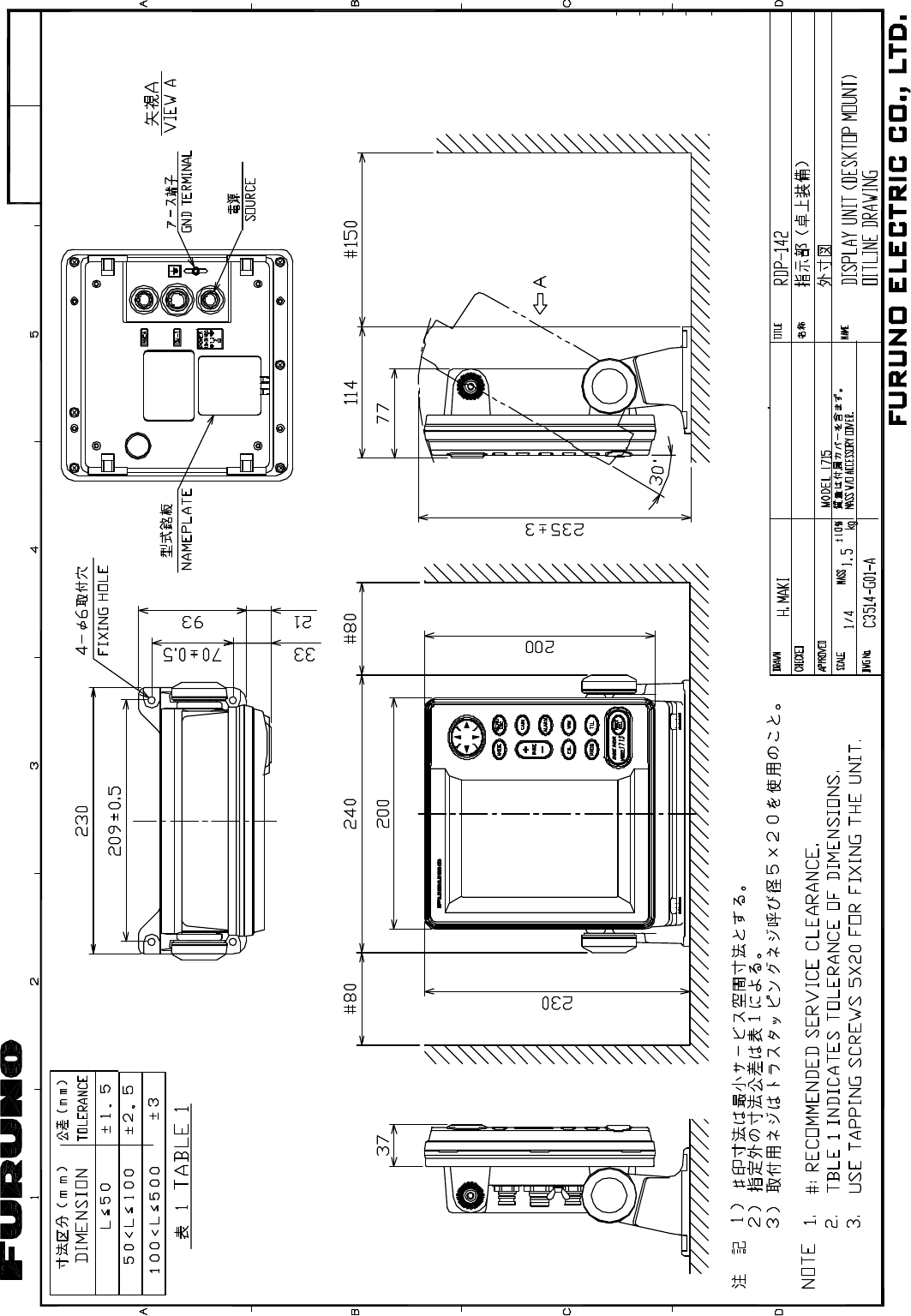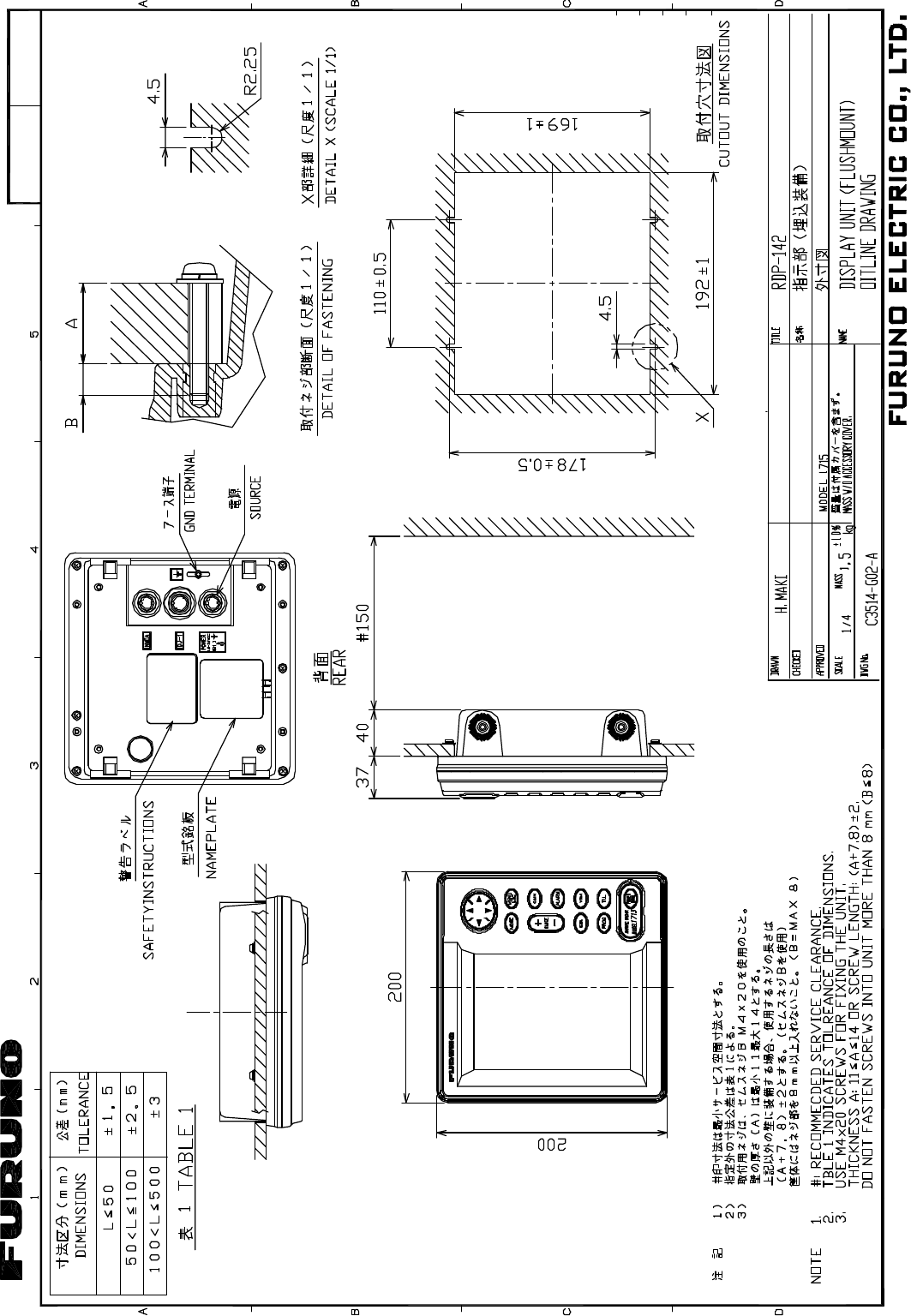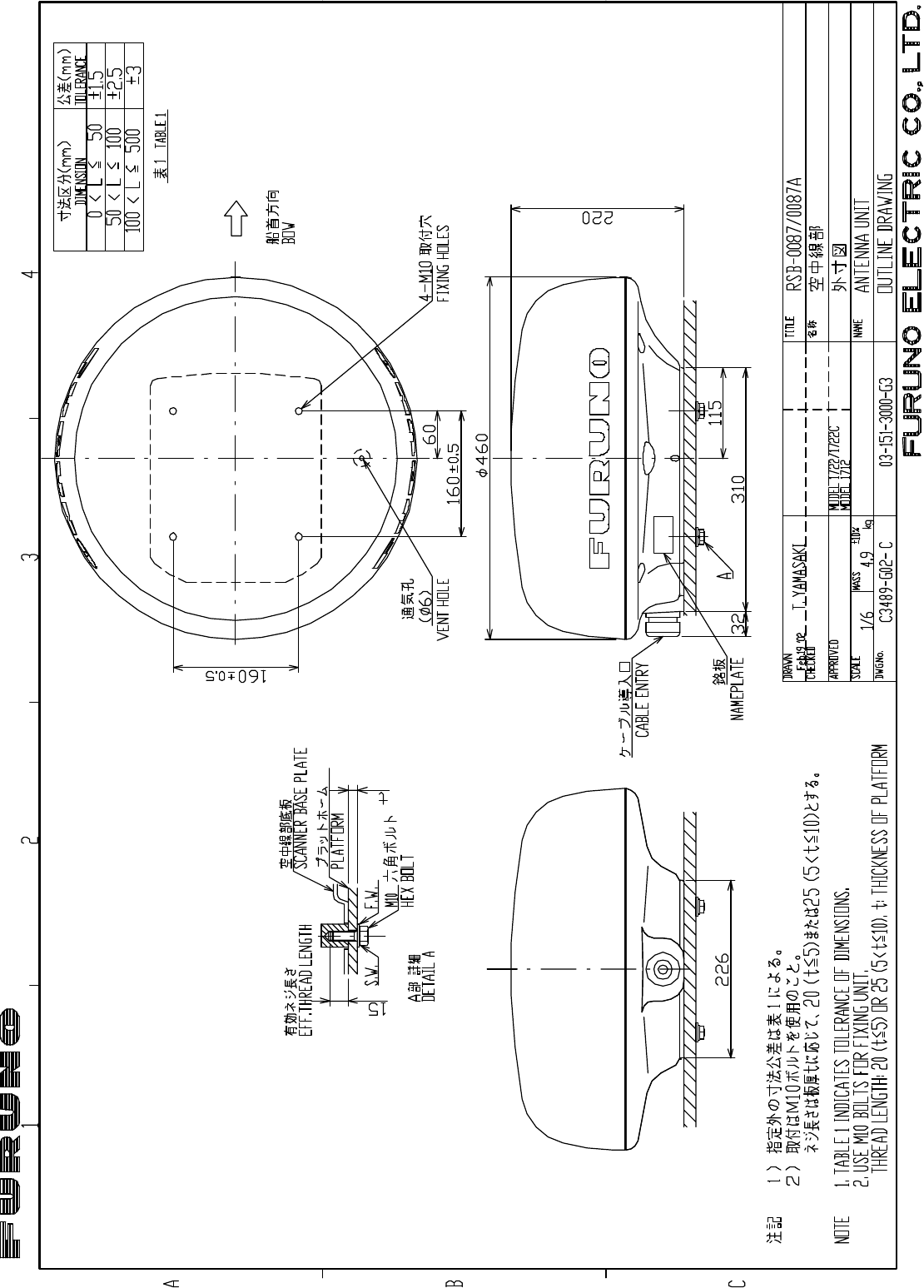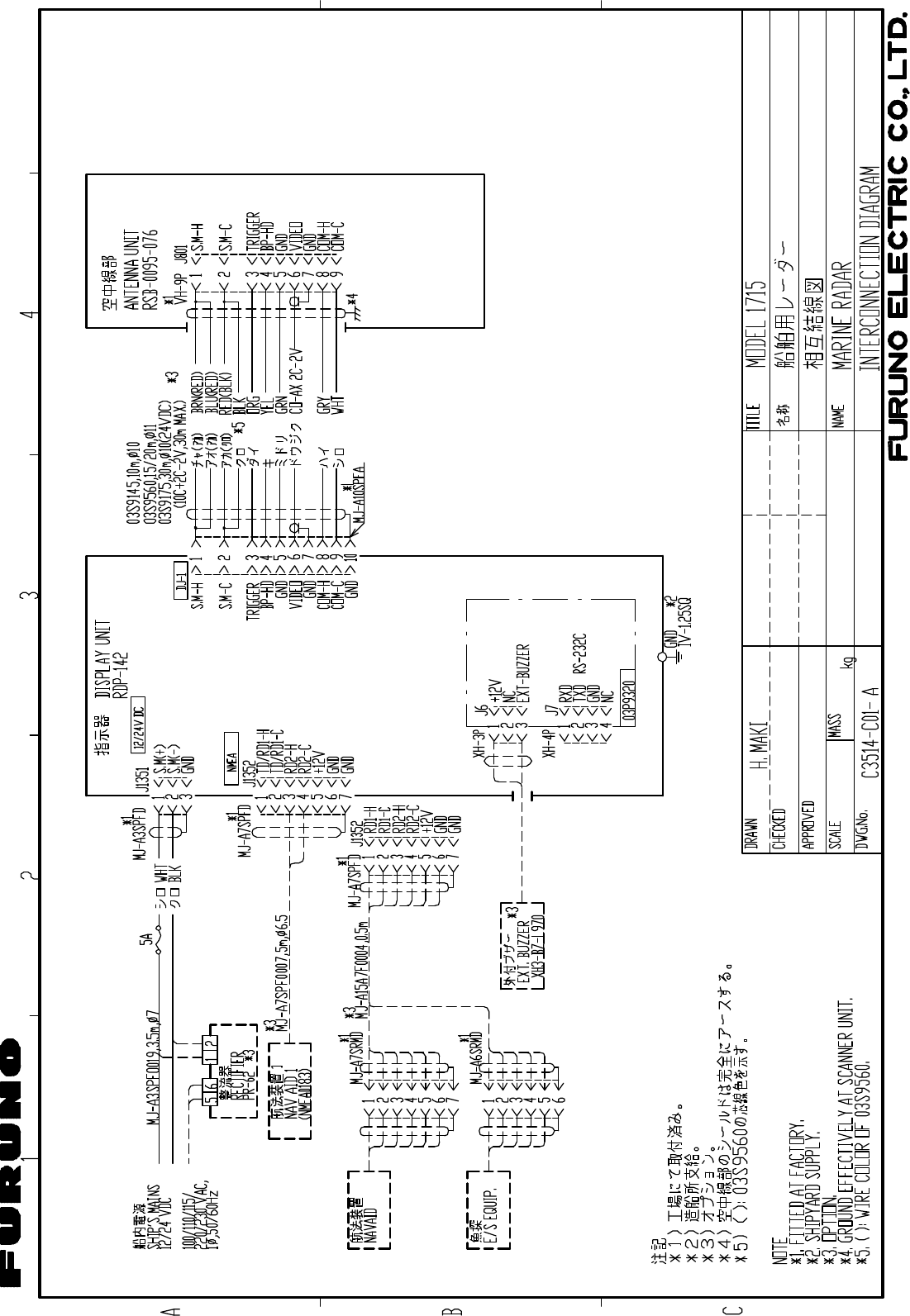Furuno USA 9ZWRTR076 marine radar User Manual M1713 OME
Furuno USA Inc marine radar M1713 OME
Operators Manual

MARINE RADAR
MODEL 1715

Your Local Agent/DealerYour Local Agent/Dealer
9-52 Ashihara-cho,9-52 Ashihara-cho,
Nishinomi
y
a, Ja
p
anNishinomi
y
a, Ja
p
an
Tele
p
hone :Tele
p
hone : 0798-65-21110798-65-2111
Telefax :Telefax : 0798-65-42000798-65-4200
F
IRST EDITION :
F
IRST EDITION : . . 00000000
Printed in JapanPrinted in Japan
A
ll ri
g
hts reserved.
A
ll ri
g
hts reserved.
PUB.No.PUB.No. OME-35140OME-35140
*00014791100**00014791100*
*00014791100**00014791100*
(( )) MODEL1715MODEL1715 * 0 0 0 1 4 7 9 1 1 0 0 ** 0 0 0 1 4 7 9 1 1 0 0 *
*OME35140Z00**OME35140Z00*
*OME35140Z00**OME35140Z00*
* O M E 3 5 1 4 0 Z 0 0 ** O M E 3 5 1 4 0 Z 0 0 *

i
TABLE OF CONTENTS
SAFETY INSTRUCTIONS............................ ii
FOREWORD............................................... iii
SYSTEM CONFIGURATION....................... iv
EQUIPMENT LISTS..................................... v
1.
OPERATION ........................................... 1
1.1
Controls .................................................. 1
1.2
Indications .............................................. 2
1.3
Turning Power On/Off ............................ 3
1.4
Transmitting, Standby............................. 3
1.5
Adjusting Display Contrast, Brilliance .... 4
1.6
Choosing the Range .............................. 4
1.7
Receiver Sensitivity................................ 4
1.8
Suppressing Sea Clutter ........................ 5
1.9
Suppressing Rain Clutter ....................... 6
1.10
Measuring the Range............................. 6
1.11
Measuring the Bearing ........................... 7
1.12
Shifting the Display ................................ 7
1.13
Zoom ...................................................... 8
1.14
User Menu Overview.............................. 8
1.15
Heading Line .......................................... 9
1.16
Interference Rejector.............................. 9
1.17
Noise Rejector...................................... 10
1.18
Echo Trail, Trail Brilliance..................... 10
1.19
Echo Stretch......................................... 10
1.20
Guard Alarm ..........................................11
1.21
Watchman ............................................ 12
1.22
Suppressing Long-range Rain Clutter.. 12
1.23
Panel Backlighting................................ 12
1.24
Hue....................................................... 13
1.25
Resetting Distance Run ....................... 13
1.26
PROG Key............................................ 13
1.27
Outputting Target Position to a Plotter . 13
1.28
Turning Navigation Data On/Off ........... 14
1.29
Setting up Nav Data Displays .............. 14
1.30
System Menu ....................................... 16
2.
MAINTENANCE, TROUBLESHOOTING
..... 18
2.1
Maintenance ......................................... 18
2.2
Replacing the Fuse...............................19
2.3
Troubleshooting ....................................19
2.4
Diagnostics ...........................................20
2.5
Test Pattern........................................... 21
2.6
Clearing the Memory ............................ 21
2.7
Replacing the Magnetron .....................21
2.8
Replacing the Synchro Belt .................. 21
3.
INSTALLATION..................................... 22
3.1
Antenna Unit Installation.......................22
3.2
Display Unit Installation ........................25
3.3
Wiring.................................................... 25
3.4
Adjustments .......................................... 26
3.5
Magnetron Heater Voltage.................... 29
MENU TREE.............................................. 30
SPECIFICATIONS ..................................SP-1
PACKING LIST
OUTLINE DRAWINGS
INTERCONNECTION DIAGRAM
SCHEMATIC DIAGRAMS
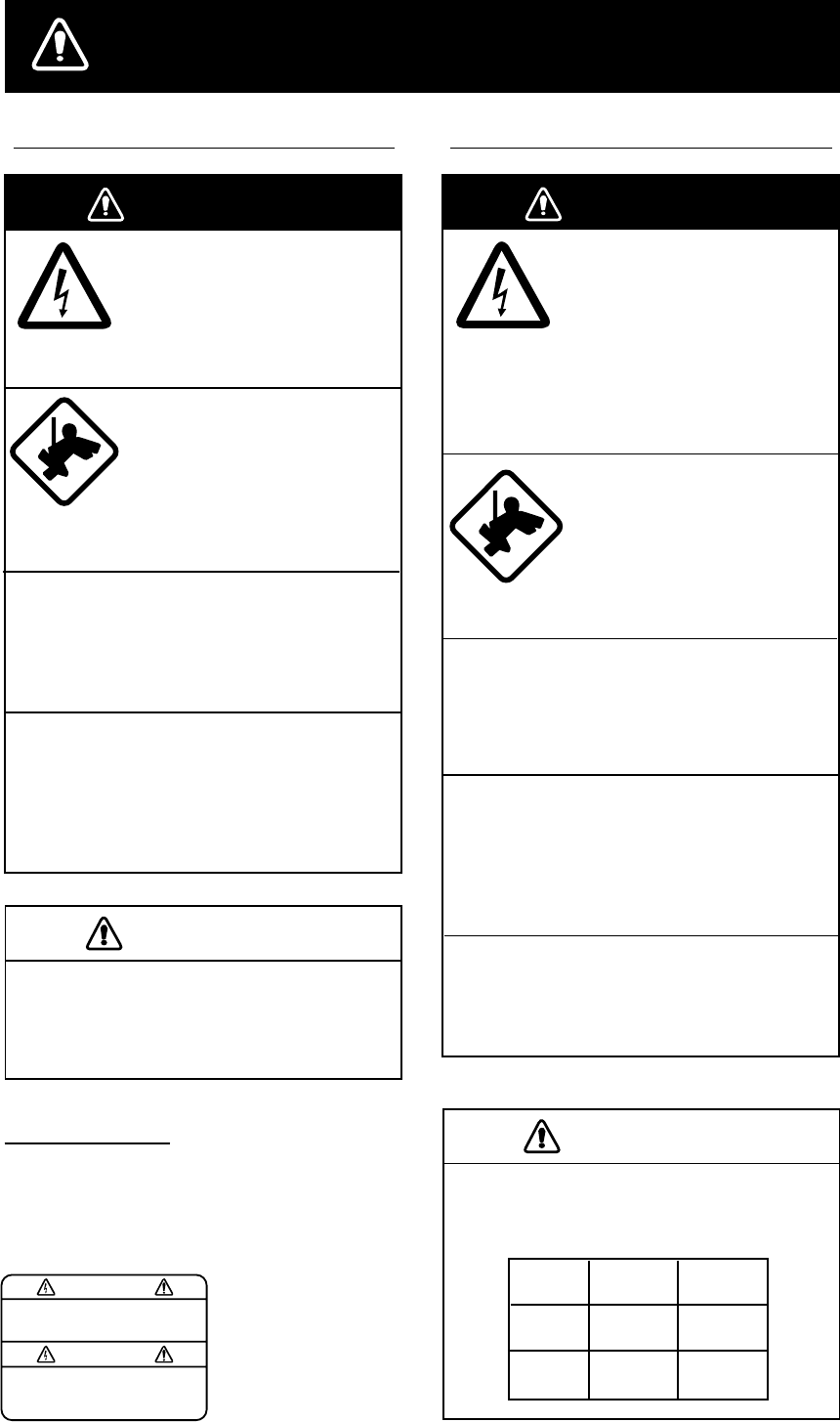
ii
SAFETY INSTRUCTIONS
Safety Instructions for the Operator
WARNING
ELECTRICAL SHOCK HAZARD
Do not open the equipment.
Only qualified personnel
should work inside the
equipment.
Wear a safety belt and hard
hat when working on the
antenna unit.
Serious injury or death can
result if someone falls from
the radar antenna mast.
Do not disassemble or modify the
equipment.
Fire, electrical shock or serious injury can
result.
Turn off the power immediately if water
leaks into the equipment or the equip-
ment is emitting smoke or fire.
Continued use of the equipment can cause
fire or electrical shock.
Use the proper fuse.
Use of a wrong fuse can damage the
equipment and void the warranty.
WARNING LABEL
A warning label is attached to the
equipment. Do not remove the label.
If the label is missing or damaged,
contact a FURUNO agent or dealer
about replacement.
WARNING
To avoid electrical shock, do not
remove cover. No user-serviceable
parts inside.
Name: Warning Label (1)
Type: 86-003-1011-1
Code No.: 100-236-231
CAUTION
Safety Instructions for the Installer
Observe the following compass safe
distances to prevent interference to a
magnetic compass:
Standard Steering
compass compass
0.60 m 0.40 m
Antenna
unit 1.25 m 0.85 m
Display
unit
ELECTRICAL SHOCK HAZARD
Do not open the equipment
unless totally familiar with
electrical circuits and
service manual.
Only qualified personnel
should work inside the
equipment.
Wear a safety belt and hard
hat when working on the
antenna unit.
Serious injury or death can
result if someone falls from
the radar antenna mast.
WARNING
Construct a suitable service platform
from which to install the antenna unit.
Serious injury or death can result if some-
one falls from the radar antenna mast.
Be sure that the power supply is
compatible with the voltage rating of
the equipment.
Connection of an incorrect power supply
can cause fire or damage the equipment.
Use only the specified power cable.
Fire or damage to the equipment can
result if a different cable is used.
CAUTION

iii
FOREWORD
A Word to the Owner of the
MODEL 1715
Congratulations on your choice of the
FURUNO MODEL 1715 Marine Radar.
For over 50 years FURUNO Electric
Company has enjoyed an enviable reputation
for innovative and dependable marine
electronics equipment. This dedication to
excellence is furthered by our extensive
global network of agents and dealers.
Your radar is designed and constructed to
meet the rigorous demands of the marine
environment. However, no machine can
perform its intended function unless installed,
operated and maintained properly. Please
carefully read and follow the recommended
procedures for installation, operation, and
maintenance.
We would appreciate hearing from you, the
end-user, about whether we are achieving our
purposes.
Thank you for considering and purchasing
FURUNO equipment.
Features
Your radar has a large variety of functions, all
contained in a rugged plastic case. All
controls respond immediately to the
operator’s command and each time a key is
pressed the corresponding change can be
seen on the screen.
The main features of the MODEL 1715 are
•
Daylight viewing radar specially designed
for small craft and sailing yachts.
•
Traditional FURUNO reliability and quality
in a compact, light-weight and low-cost
radar.
•
Compact and light-weight radome antenna
with precision 45 cm center-fed radiator.
•
High definition 7-inch monochrome LCD
display.
•
Automatic control of sensitivity (gain),
tuning and A/C SEA for simplified
operation.
•
Targets can be displayed in grey tones on
a white background or vice versa, for
optimal viewing under any lighting
conditions.
•
On-screen alphanumeric readout of all
operational information.
•
User programmable nav data displays.
•
[PROG] key acts as a menu shortcut key.
•
[TLL] key outputs chosen target’s L/L
position to a plotter.
•
Standard features include Display Shift,
EBL, Echo Stretch, Echo Trail, Guard
Alarm, Interference Rejector, VRM, Zoom.
•
Guard zone watches for targets entering
(or exiting) a guard zone.
•
Operates on 12 or 24 V DC power.
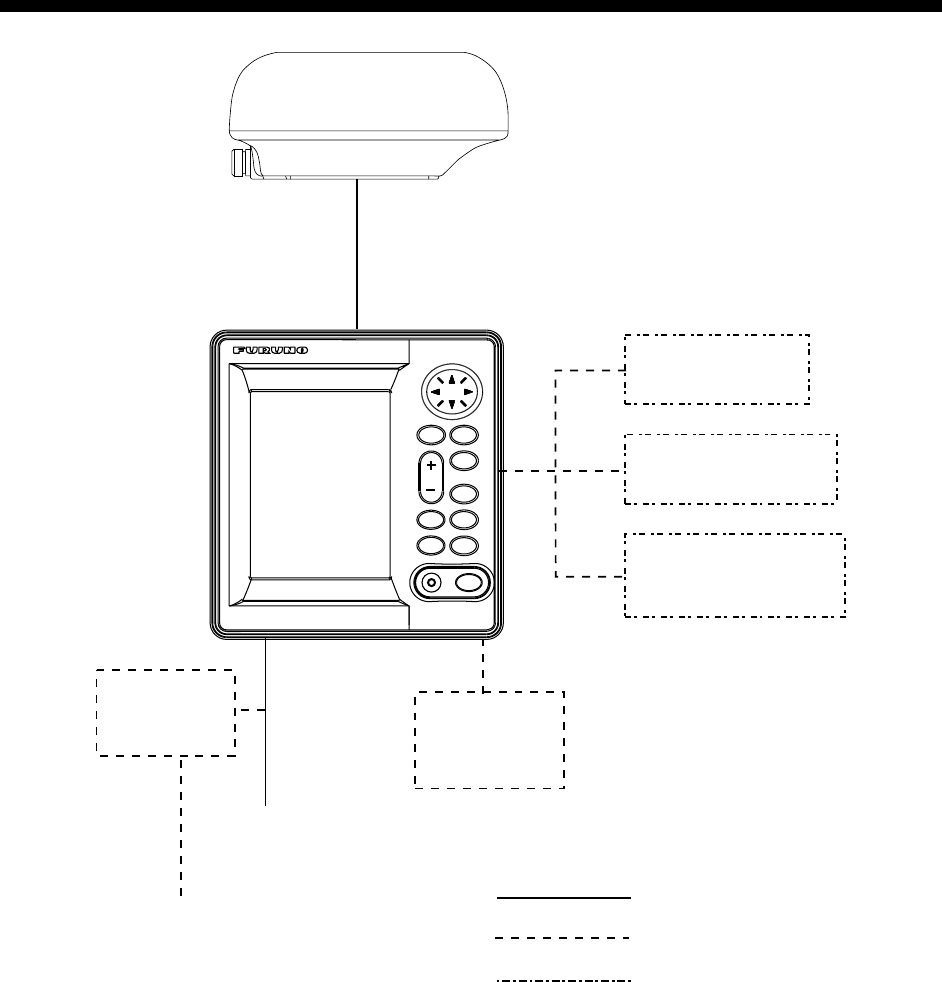
iv
SYSTEM CONFIGURATION
DISPLAY UNIT
RDP-142
EXTERNAL
BUZZER
XH3-BZ-L970
SHIP'S MAINS
12-24 VDC
RECTIFIER
PR-62
: Standard supply
: Optional supply
: Local supply
SHIP'S MAINS
115/230 VAC,
1
φ
, 50/60 Hz
NAVIGATOR
or ECHO SOUNDER
(NMEA 0183)
ESC
MENU
MODE
VRMEBL
POWER
BRILL
GAIN
ALARM
RANGE
GPS RECEIVER
GP-310B/320B
WIND INDICATOR,
SPEED INDICATOR
ANTENNA UNIT
RSB-0095
TLL
PROG

v
EQUIPMENT LISTS
Standard supply
Name Type Code No. Qty Remarks
Antenna Unit RSB-0095 — 1
Display Unit RDP-142 — 1
CP03-25301 008-442-280 1 set For antenna unit, including EMI core
CP03-24910 000-080-231 Antenna cable (10 m)
CP03-24920 000-080-232 Antenna cable (15 m)
CP03-24930 000-080-233
1 set
Antenna cable (20 m)
Installation
Materials*
CP03-25101 008-441-250 1 set For display unit, including tapping
screws for mounting hanger
Spare Parts* SP03-09800 000-085-441 1 set Fuse
*: See packing list at end of manual.
Option
Name Type Code No. Qty Remarks
Buzzer Assy. XH3-BZ-L970 000-146-422 1 With connector, 0.9 m
Cable Assy. MJ-A7SPF0007-050 000-144-418 1 Connector at one end, 5
m, for NMEA equipment
Cable Assy. MJ-A15A7F0004-005 000-145-690 1
For NMEA equipment, 0.5
m, connector at both ends,
7P-7P/6P
Cable Assy. A15A7F0005-020 000-145-691 1 7P-7P, for NMEA
equipment, 2 m
Cable Assy. MJ-A10SPF0003-300 000-130-034 1 Antenna cable, 30 m, for
24 VDC power
Radome Mounting
Bracket OP03-93 008-445-080 1
For mounting antenna unit
on a sailboat
PR-62 000-013-484
100 VAC
PR-62 000-013-485
115 VAC
PR-62 000-013-486
220 VAC
Rectifier
PR-62 000-013-487
1
230 VAC
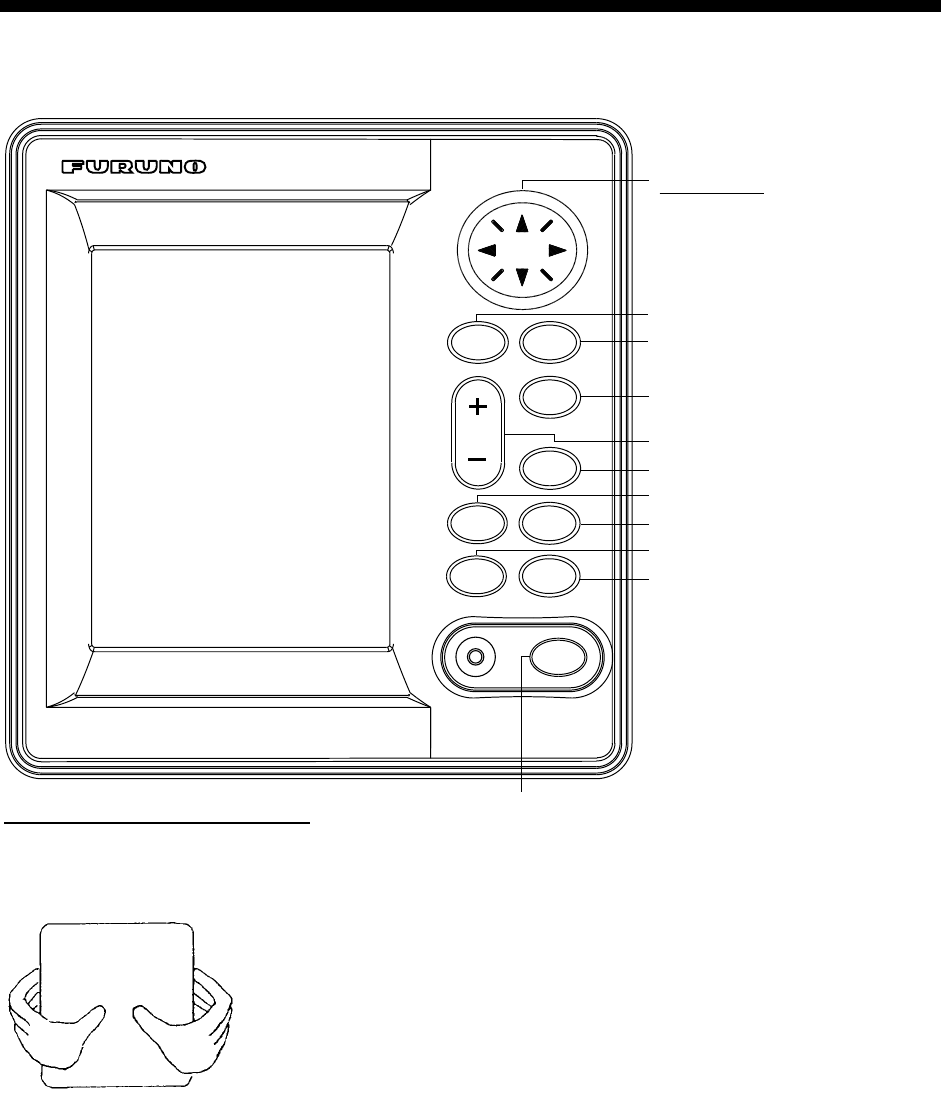
1
1. OPERATION
1.1 Controls
Cursor Pad
Chooses menu items;
adjusts VRM, EBL and cursor.
Opens/closes menu;
escapes from current operation.
Chooses display mode.
Opens dialog box for adjustment
of gain, A/C SEA, A/C RAIN.
Chooses radar range.
Enables/disables guard alarm.
Turns EBL on/off.
Short press: Turns power on.
Long press: Turns power off.
Momentary press: Opens dialog box for
(power turned on) adjustment of display
contrast, brilliance
and mode (TX, ST-BY)
selection.
ESC
MENU
MODE
VRMEBL
POWER
BRILL
GAIN
ALARM
RANGE
TLL
PROG
Turns VRM on/off.
Shortcut key
Outputs chosen target’s L/L
position to plotter.
How to remove the hard cover
Place your thumbs at the center
of the cover, and then lift the cover while
pressing it with your thumbs.
Display unit
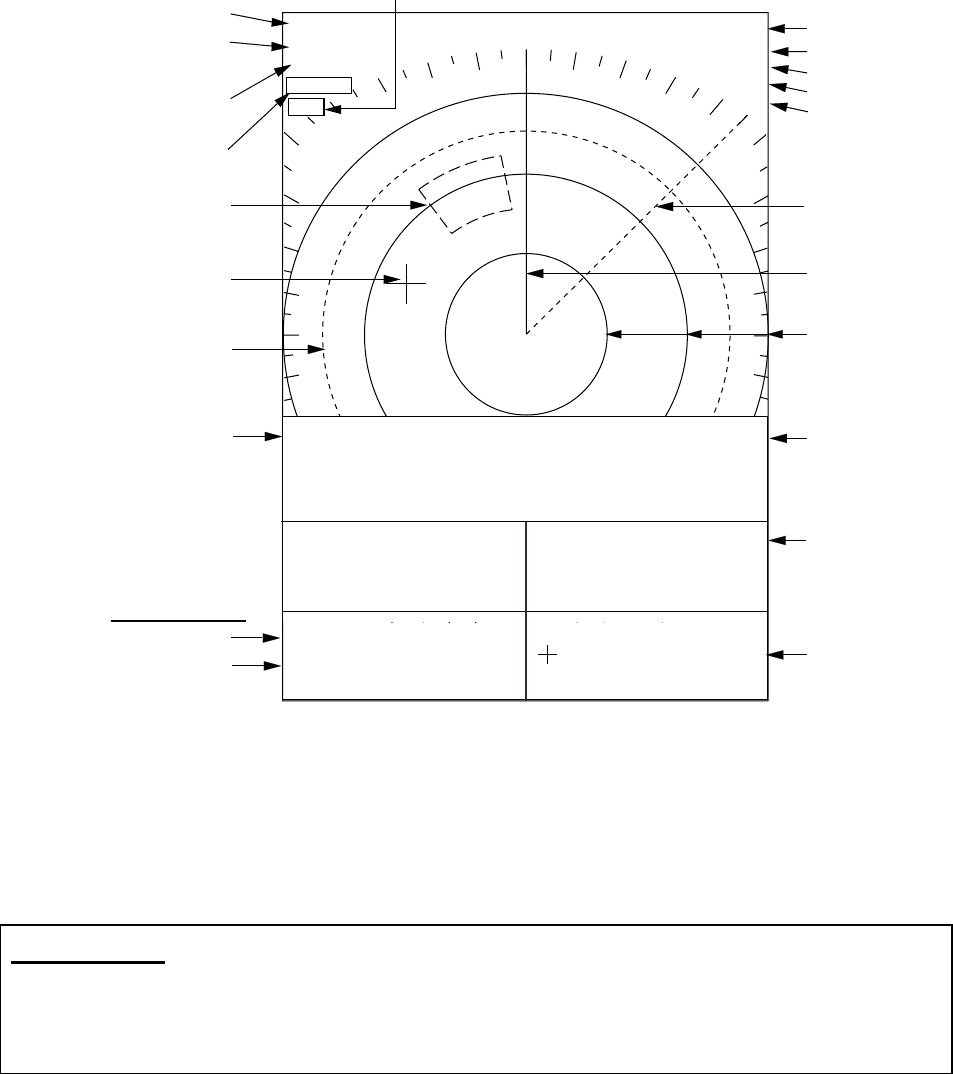
1. OPERATION
2
1.2 Indications
TRAIL
G(IN)
ES H
IR H
FTC
0.5
1.5nm
ZOOM
Range
Range ring
interval
Zoom
Echo trails
Guard alarm (IN or OUT)
Echo stretch
Rain clutter suppressor
Guard
zone
Cursor
EBL
Range rings
Range, bearing and
time-to-go to cursor
location
(Cursor latitude and
longitude position
also available if radar
is interfaced with
a navigator.)
EBL bearing
VRM range
VRM
Watchman
Heading line
WATCH
SIM
Simulation mode
Interference rejector
Appropriate sensors required to display nav data.
EBL/VRM Box
EBL
VRM
45.0°
1.25
RNG 06.2nm
BRG 283.2°
TTG: 02H21M
Rng
XTE
Brg
Cse
8.56 nm
0.39 nm
306°
155°
Trip meter Position
34°22.539 N
136°07.516 E
Range,
XTE (Cross-track error)
Position
Bearing,
Course
Indications
About the LCD
The high quality LCD displays better than 99.99% of its picture elements. The remaining 0.01%
may drop out or light, however this is not an indication of malfunction; it is a characteristic of the
LCD.
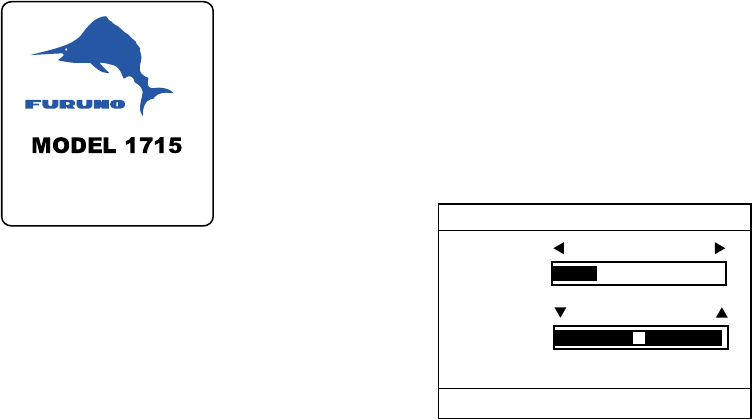
1. OPERATION
3
1.3 Turning Power On/Off
Press the [POWER/BRILL] key to turn on the
power. The unit beeps, the startup screen
appears, and then the equipment checks the
ROM and RAM for proper operation and
displays program number. The ROM and
RAM check shows OK or NG (No Good). If
NG appears, try to press any key except the
[POWER/BRILL] key to start operation.
However, the equipment may not work
properly. Contact your dealer for advice.
XX.XX = Program version no.
ROM : OK RAM : OK
Program No: 0359199-XX.XX
FURUNO ELECTRIC CO., LTD.
7" LCD MARINE RADAR
Startup screen
After the completion of the startup test, a
timer displays the time remaining for warm up
of the magnetron (the device which transmits
radar pulses), counting down from 1:00 to
0:00.
To turn off the power, press and hold down
the [POWER/BRILL] key (about three
seconds) until the screen goes blank.
Provided that the radar was once in use with
the transmitter tube (magnetron) still warm,
you can turn the radar into TRANSMIT
condition without 1-minute of warm-up. If the
[POWER/BRILL] switch was accidentally
turned off and you want to restart the radar
promptly, turn on the [POWER/BRILL] switch
not later than 15 seconds after power-off.
Note 1: In a cold environment the screen
appears “foggy” when the power is turned on
but is soon restored to normal condition.
Note 2: The example screens shown in this
manual may not match the screens you see
on your display. The screen you see depends
on your system configuration and equipment
settings.
1.4 Transmitting, Standby
After the power is turned on and the
magnetron has warmed up, “ST-BY”
(Stand-by) appears, indicating the radar is
ready to transmit radar pulses.
To toggle between transmit and stand-by, do
the following:
1. With the power turned on, press the
[POWER/BRILL] key momentarily to show
the brilliance/contrast adjustment window.
CONT: 4
LOW HIGH
BRILL:
LOW HIGH
9
BRILL/CONTRAST
[MODE]: TX/ST-BY
[MENU/ESC] : Exit.
Brilliance/contrast adjustment window
2. Press the [MODE] key to go to stand-by
and transmit status alternately.
Note: If you attempt to transmit before
“ST-BY” appears, the beeps sound and
the radar does not transmit pulses. Wait
until “ST-BY” appears.
3. Press the [MENU/ESC] key to close the
window.
When radar pulses are transmitted the radar
receiver is automatically tuned. Echoes
appear in four levels of digitized video
according to echo strength. When a target is
beneath a marker (VRM, EBL, heading line,
range ring) the part of the marker where the
target lies is displayed in reverse video.
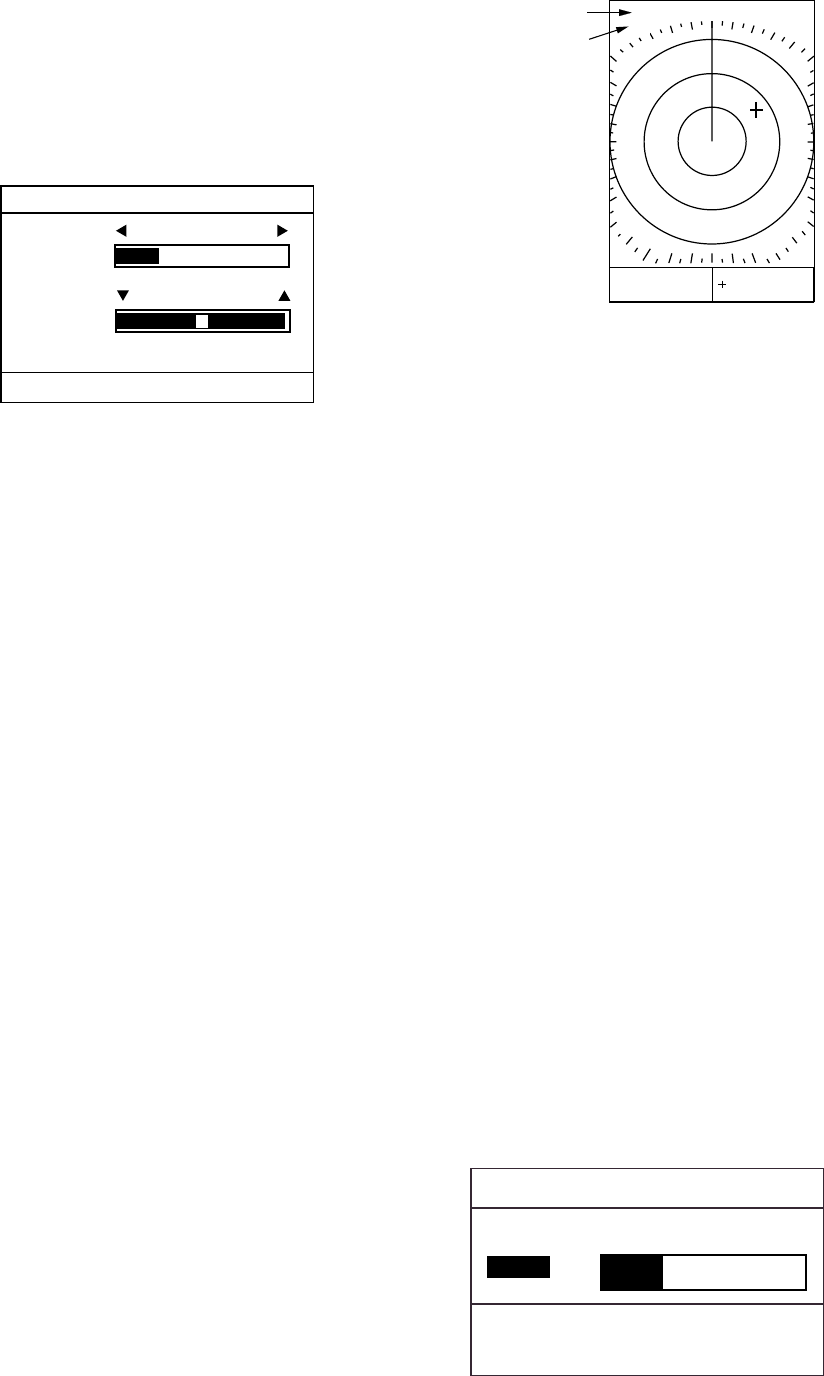
1. OPERATION
4
1.5 Adjusting Display
Contrast, Brilliance
1. With the power turned on, press the
[POWER/BRILL] key momentarily to show
the brilliance/contrast adjustment window.
CONT: 4
LOW HIGH
BRILL:
LOW HIGH
9
BRILL/CONTRAST
[MODE]: TX/ST-BY
[MENU/ESC] : Exit.
Brilliance/contrast adjustment window
2. Press ◄ or ► to adjust contrast.
3. Press ▲ or ▼ to adjust brilliance.
4. Press the [MENU/ESC] key to escape.
Note 1: Windows other than menu windows
are erased when there is no operation within
about 10 seconds.
Note 2: The radar starts up with the last-used
brilliance level after the startup screen
appears. Therefore, adjust the brilliance if it is
too low at startup.
1.6 Choosing the Range
The range selected automatically determines
the range ring interval, the number of range
rings and pulse repetition rate.
Press the [RANGE+] or [RANGE-] key to
choose the range. The range and range ring
interval appear at the top left corner on the
screen.
Range
Range ring
interval
6.0
nm
2.0
RNG 03.2nm
BRG 60.2°
TTG 02H21M
EBL - - - .-°
VRM - - - -nm
Location of range and range ring
interval indications
1.7 Receiver Sensitivity
The [GAIN] key adjusts the sensitivity (gain)
of the receiver. It works in precisely the same
manner as the volume control of a broadcast
receiver, amplifying the signals received.
To set the sensitivity, you first choose the
automatic sensitivity setting which best
matches current sea condition. Then, if
necessary, you may fine tune the sensitivity
manually. The proper setting is such that the
background noise is just visible on the
screen.
If you set up for too little sensitivity, weak
echoes may be missed. On the other hand
excessive sensitivity yields too much
background noise; weak targets may be
missed because of the poor contrast between
desired echoes and the background noise on
the display.
1. Press the [GAIN] key consecutively until
the display shown below appears.
GAIN
20
[GAIN] : A/C SEA MENU
[MENU/ESC] : Exit.
AUTO : MODERATE
MANU
Gain adjustment window
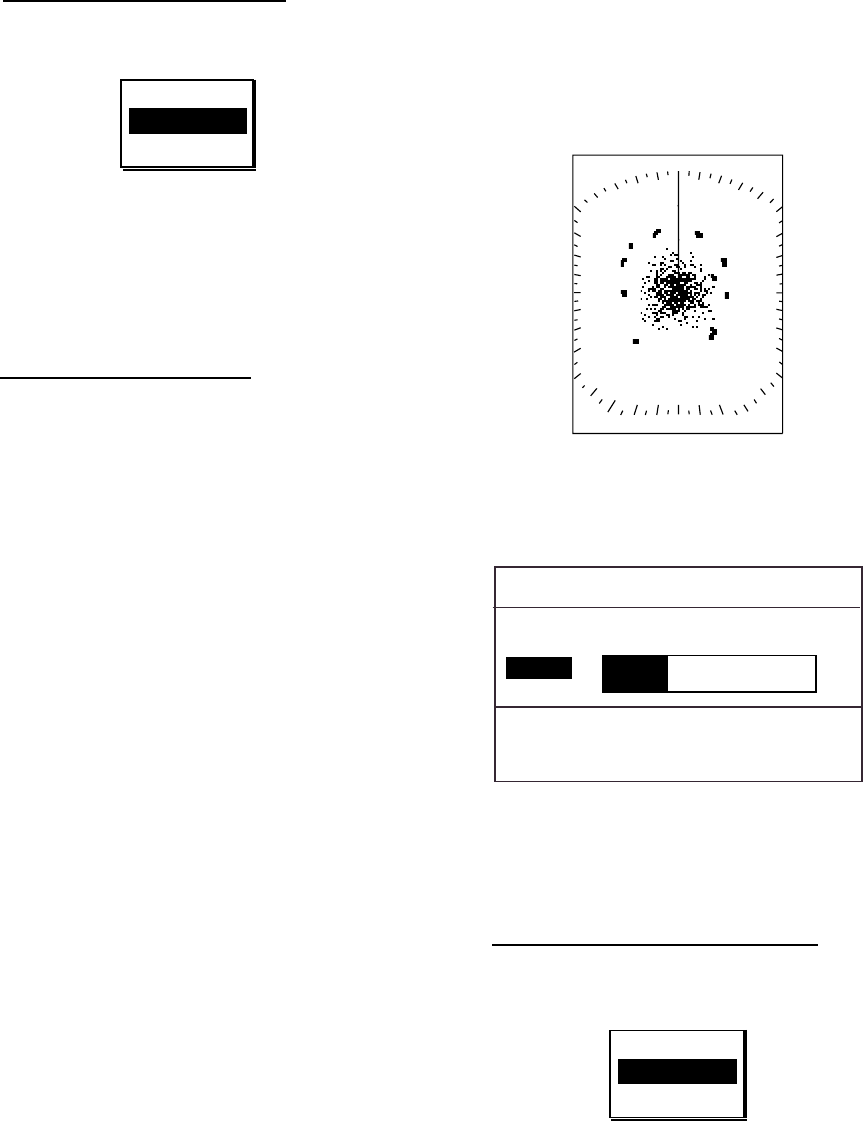
1. OPERATION
5
2. Press ▲ or ▼ to choose AUTO or MANU
as appropriate.
Automatic gain adjustment
1) Press ► to open the automatic gain
options window.
ROUGH
MODERATE
CALM
Automatic gain options
2) Press ▲ or ▼ to choose ROUGH,
MODERATE or CALM depending on
sea conditions.
3) Press ◄ to close the window.
Manual gain adjustment
While observing the screen and the gain
tuning bar, press ◄ or ► to adjust the
gain. The setting range is 0-100.
3. Press the [MENU/ESC] key to finish.
1.8 Suppressing Sea Clutter
In rough weather, returns from the sea
surface, called sea clutter, are received over
several miles around own ship and mask
nearby targets. This situation can be
improved by properly suppressing the sea
clutter with the A/C SEA control.
To set the A/C SEA, you first choose the
automatic A/C SEA setting which best
matches current sea conditions. Then, if
necessary, you may fine tune the A/C SEA
manually.
In most cases suppress the clutter until it has
disappeared to leeward, but a little is still
visible windward. If the setting is too low,
targets will be hidden in the clutter, while if it
is set too high, both sea clutter and targets
will disappear from the display.
A common mistake is too over-suppress sea
clutter so that it is completely removed. You
can see how dangerous this can be by setting
up for maximum A/C SEA: A dark zone will be
created near the center of the screen,
causing a loss of close-in targets. This dark
zone is even more dangerous if the sensitivity
has not been properly adjusted.
Always leave a little sea clutter visible on the
screen, first adjusting automatically and then
fine tuning with the manual control as
necessary.
Sea clutter at screen center
1. Press the [GAIN] key consecutively until
the display shown below appears.
A/C SEA
20
[GAIN] : A/C RAIN MENU
[MENU/ESC] : Exit.
AUTO : MODERATE
MANU
A/C SEA adjustment window
2. Press ▲ or ▼ to choose AUTO or MANU
as appropriate.
Automatic A/C SEA adjustment
1) Press ► to open the automatic A/C
SEA options window.
ROUGH
MODERATE
CALM
A/C SEA options
2) Press ▲ or ▼ to choose ROUGH,
MODERATE or CALM depending on
sea conditions.
3) Press ◄ to close the window.
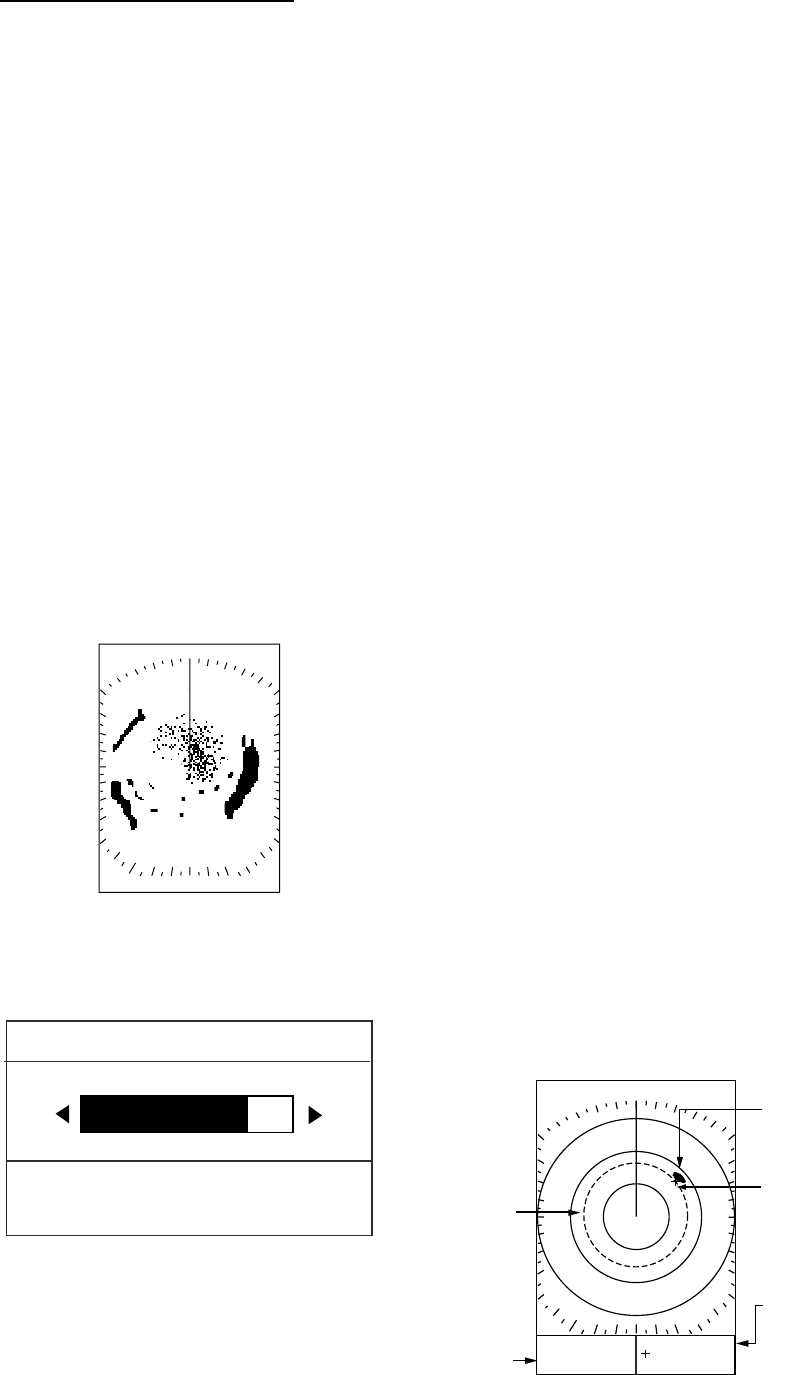
1. OPERATION
6
Manual A/C SEA adjustment
While observing the screen and the A/C
SEA tuning bar, press ◄ or ► to adjust
the A/C SEA. The setting range is 0-100.
4. Press the [MENU/ESC] key to finish.
1.9 Suppressing Rain Clutter
The vertical beamwidth of the antenna is
designed to see surface targets even when
the ship is rolling. However, by this design the
antenna will also pick up rain clutter (rain,
snow, or hail) in the same manner as normal
targets. The illustration below shows the
appearance of rain clutter on the display.
The A/C RAIN control adjusts the receiver
sensitivity as the A/C SEA control does but
rather in a longer time period (longer range).
The higher the setting the greater the
anti-clutter effect.
Rain clutter at screen center
1. Press the [GAIN] key consecutively until
the display shown below appears.
A/C RAIN
[GAIN] : GAIN MENU
[MENU/ESC] : Exit.
65
A/C RAIN adjustment window
2. While observing the screen and the A/C
RAIN tuning bar, press ◄ or ► to adjust
the A/C RAIN. The setting range is 0-100.
3. Press the [MENU/ESC] key to finish.
1.10 Measuring the Range
The bearing to a target can be measured by
the range rings, by the cursor and by the
VRM (Variable Range Marker).
Measuring range by the cursor
Operate the cursor pad to place the cursor on
the inside edge of the target. Read the range
to the cursor at the bottom right corner of the
display.
Measuring range by the range rings
Count the number of rings between the
center of the display and the target. Check
the range ring interval and judge the distance
of the echo from the inner edge of the nearest
ring.
Measuring range by the VRM
1. Press the [VRM] key to display the VRM.
The message “Adjust VRM by cursor”
appears and “VRM” in the EBL/VRM box
is displayed in reverse video. The
message is automatically erased after 10
seconds, or you may erase it sooner by
pressing any key.
2. Operate the cursor pad to place the VRM
on the inside edge of the target.
3. Check the VRM readout at the bottom left
corner on the screen to find the range to
the target.
To anchor the VRM, press the [MENU/ESC]
key. (It is automatically anchored if there is no
key operation for about 10 seconds.) To
erase the VRM, press the [VRM] key.
6.0
nm
2.0
Target
VRM
VRM
range
Range, bearing
and time-to-go
to cursor
location
RNG 2.22nm
BRG 45.62°
TTG 02H21M
Cursor
EBL
- - -
.-
°
VRM
2.91
nm
How to measure the range
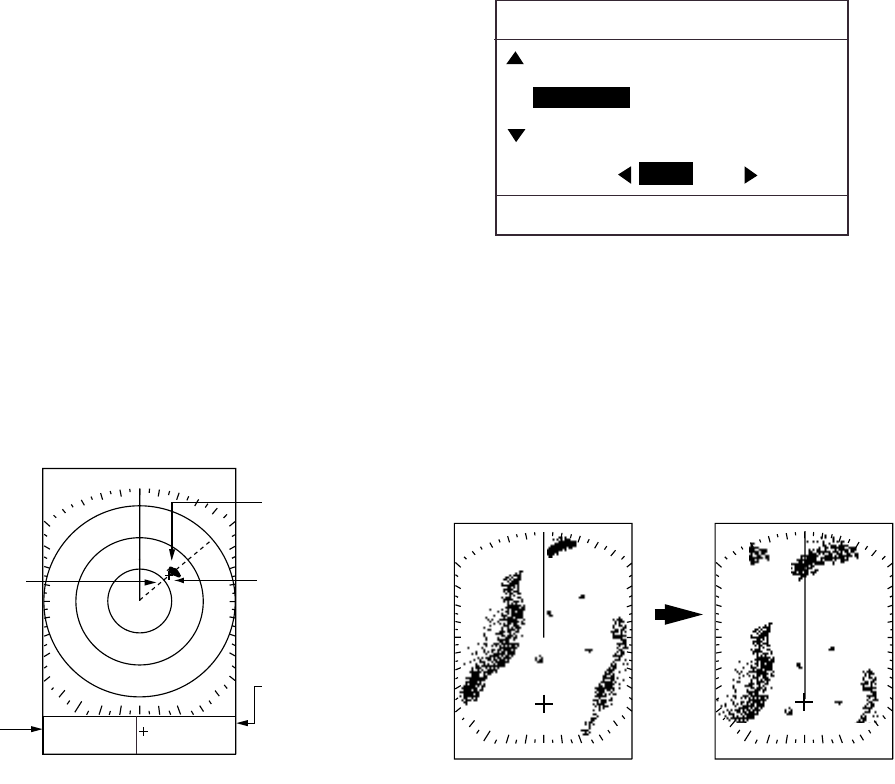
1. OPERATION
7
1.11 Measuring the Bearing
The bearing to a target can be measured with
the cursor and the EBL (Electronic Bearing
Line).
Measuring bearing with the cursor
Operate the cursor pad to place the cursor on
the inside edge of the target. Read the
bearing to the target at the bottom right
corner.
Measuring bearing with the EBL
1. Press the [EBL] key to show the EBL. The
message “Adjust EBL by cursor” appears
and “EBL” in the EBL/VRM box is
displayed in reverse video. The message
is automatically erased after 10 seconds,
or you may erase it sooner by pressing
any key.
2. Operate the cursor pad to bisect the
target with the EBL.
3. Check the EBL readout at the bottom left
corner on the screen to find the bearing to
the target.
To anchor the EBL, press the [MENU/ESC]
key. (It is automatically anchored if there is no
key operation for about 10 seconds.) To
erase the EBL, press the [EBL] key.
6.0
nm
2.0
EBL
bearing
RNG 2.22nm
BRG 45.62°
TTG 02H21M
Range, bearing
and time-to-go
to cursor
location
Target
EBL Cursor
EBL 45.62
°
VRM
- - - -
nm
Measuring range by the EBL and cursor
1.12 Shifting the Display
Own ship position, or sweep origin, can be
displaced manually or automatically to
expand the view field without switching to a
longer range. The default shift method is
manual.
If shift is activated when nav data is displayed,
the nav data is automatically erased.
1. Use the cursor pad to place the cursor
where you want to shift own ship position.
2. Press the [MODE] key to show the
Display Mode menu.
DISPLAY MODE
[MENU/ESC] : Exit
SHIFT (MANUAL)*
NORMAL
ZOOM
NAV DISP OFF ON
* UTO i d f M NU L
Display mode menu
*: If SHIFT (AUTO) is shown, open the
System menu and set SHIFT MODE to
MANUAL. For further details, see SHIFT
MODE on page 17.
3. Press ▲ to choose SHIFT (MANUAL).
4. Press the [MENU/ESC] key to close the
menu.
Select where to shift Shifted display
with the cursor.
Choose
manual
SHIFT
mode.
How the manual shift works
To cancel the shifted display, open the
Display Mode menu, set SHIFT to NORMAL
and then press the [MENU/ESC] key.
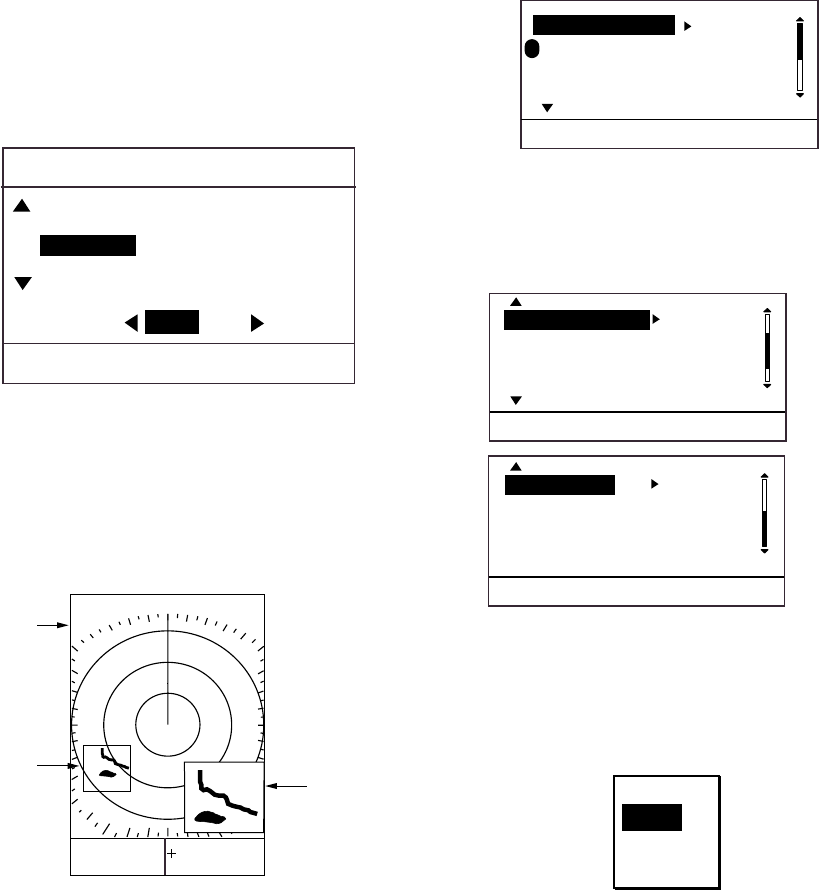
1. OPERATION
8
1.13 Zoom
The zoom feature allows you to double the
size of a selected area.
If zoom is activated when nav data is
displayed, the nav data is automatically
erased.
1. Use the cursor pad to place the cursor
where you want to zoom.
2. Press the [MODE] key to show the display
mode menu.
DISPLAY MODE
[MENU/ESC] : Exit
SHIFT (MANUAL)*
NORMAL
ZOOM
NAV DISP OFF ON
Display mode menu
3. Press ▼ to choose ZOOM.
4. Press the [MENU/ESC] key to close the
menu. “ZOOM” appears at the top left
corner when the zoom feature is turned
on.
6.0
nm
2.0
ZOOM
Zoom
Window
RNG 4.43nm
BRG 231.3°
TTG: 02H21M
+
Cursor
EBL
- - -
.-
°
VRM - - - -nm
ZOOM
Zoom display
To cancel the zoom display, open the Display
Mode menu, choose NORMAL and then
press the [MENU/ESC] key. To choose new
zoom location, restore to the NORMAL mode
and then repeat the zoom procedure.
1.14 User Menu Overview
The User menu, consisting of three pages of
menus, contains 12 items which the user may
set according to conditions or preference.
1. Press the [MENU] key to open the User
menu.
P
(1/3)
INT REJECTION LOW
ECHO STRETCH : LOW
FTC : OFF
NOISE REJECTION: LOW
[MENU/ESC] : Exit.
*
* = "P" shows current function of PROG key
User menu, page 1
2. Use ▲ or ▼ to scroll the menu to display
desired item in reverse video.
Page 2
(3/3)
Page 3
WATCHMAN TIME OFF
HUE : DAY
PANEL DIMMER : OFF
HDG LINE OFF
[MENU/ESC] : Exit.
(2/3)
ECHO TRAIL OFF
TRAIL BRILLIANCE : LOW
TRIPLOG RESET?
SYSTEM MENU...
[MENU/ESC] : Exit.
User menu, pages 2 and 3
3. Press ► to show the options window for
the item selected. For example, the
illustration below shows the interference
rejector options window.
OFF
LOW
MEDIUM
HIGH
Interference rejector options
4. Press ▲ or ▼ to choose option desired.
5. Press ◄ to continue menu operation, or
press the [MENU/ESC] key to register
your selection and close the User menu.
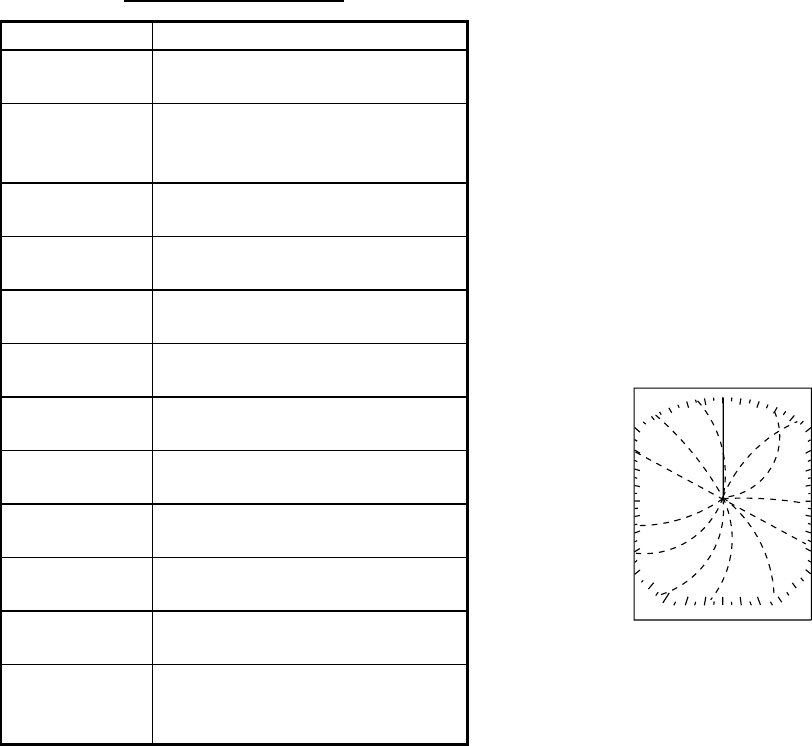
1. OPERATION
9
User menu description
Item Description
INT
REJECTION
Rejects radar interference.
ECHO
STRETCH
Stretches echoes in range
direction or range and bearing
direction.
FTC Suppresses long-range rain
clutter.
NOISE
REJECTION
Rejects noise.
WATCHMAN
TIME
Periodically checks for targets
in guard zone.
HUE Chooses echo and background
tones.
PANEL
DIMMER
Adjusts panel backlighting.
HDG LINE
OFF
Temporarily turns the heading
line off.
ECHO TRAIL Shows echo movement in
afterglow.
TRAIL
BRILLIANCE
Adjusts echo trail brilliance.
TRIPLOG
RESET?
Resets distance run.
SYSTEM
MENU
Opens the system menu. For
description see paragraph
1.30.
1.15 Heading Line
The heading line indicates the ship’s heading
and it is the solid line which appears at zero
degrees on the bearing scale.
To temporarily erase the heading line to look
at targets existing dead ahead of own ship,
do the following:
1. Press the [MENU/ESC] key to open the
User menu.
2. Press ▲ or ▼ to choose HDG LINE OFF
from page 2.
3. Press ► to turn the heading line off. The
line stays off while ► is pressed.
4. Press the [MENU/ESC] key to close the
menu.
1.16 Interference Rejector
Mutual radar interference may occur in the
vicinity of another shipborne radar operating
in the same frequency band (9 GHz). It is
seen on the screen as a number of bright
spikes either in irregular patterns or in the
form of usually curved spoke-like dotted lines
extending from the center to the edge of the
picture. This type of interference can be
reduced by activating the interference rejector
circuit. “IR” and the rejection level indicator
“L,” “M” or “H” appear at the top right corner
when the interference rejector circuit is on.
Appearance of interference
Turn off the interference rejector when no
interference exists, to avoid missing small
targets.
1. Press the [MENU/ESC] key to open the
User menu.
2. Press ▲ or ▼ to choose INT REJECTION
from page 1.
3. Press ► to open the options window.
4. Press ▲ or ▼ to choose OFF, LOW,
MEDIUM or HIGH as appropriate.
5. Press the [MENU/ESC] key to finish.
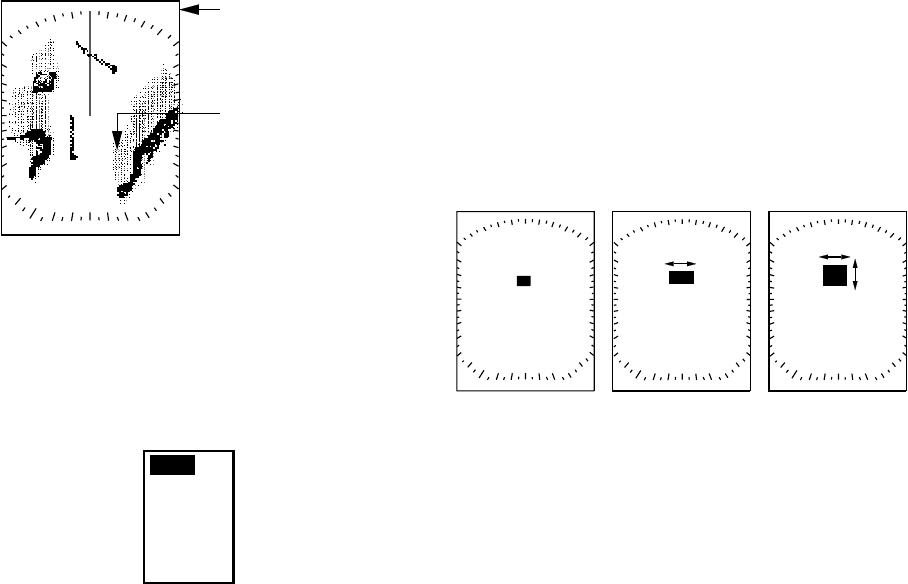
1. OPERATION
10
1.17 Noise Rejector
The noise rejector suppresses white noise,
which appears on the screen as many dots
scattered randomly over the display.
1. Press the [MENU/ESC] key to open the
User menu.
2. Press ▲ or ▼ to choose NOISE
REJECTION from page 1.
3. Press ► to open the options window.
4. Press ▲ or ▼ to choose OFF, LOW or
HIGH as appropriate.
5. Press the [MENU/ESC] key to close the
menu.
1.18 Echo Trail, Trail Brilliance
Echo trails are the afterglow of target echoes
that represent their movements relative to
own ship. They are useful for monitoring
target movement.
Trails are painted for the time period chosen.
When the time period has elapsed, trails are
erased and restarted. Trails are also erased
and restarted whenever the range is changed
or zoom or shift is activated.
30S TRAIL
Trail time
(No time shown
in case of
continuous trails)
Echo trail
Echo trails
1. Press the [MENU/ESC] key to open the
User menu.
2. Press ▲ or ▼ to choose ECHO TRAIL
from page 3.
3. Press ► to open the options window.
OFF
30sec
1min
3min
6min
CONTIN.
Echo trail options
4. Press ▲ or ▼ to choose appropriate time,
or OFF to cancel echo trails. “CONTIN.”
paints trails continuously.
5. Press ◄ to close the options window.
6. Press ▼ to choose TRAIL BRILLIANCE.
7. Press ► to open the options window.
8. Press ▲ or ▼ to choose LOW or HIGH
as appropriate.
9. Press the [MENU/ESC] key to close the
menu.
“TRAIL” and trail time (no time shown in case
of “CONTIN.”) are shown at the upper
right-hand corner on the screen.
1.19 Echo Stretch
On long ranges target echoes tend to shrink,
making them difficult to see. To enhance
target video on long ranges, use the echo
stretch feature.
1. Press the [MENU/ESC] key to open the
User menu.
2. Press ▲ or ▼ to choose ECHO
STRETCH from page 1.
3. Press ► to open the options window.
4. Press ▲ or ▼ to choose OFF, LOW or
HIGH as appropriate. LOW stretches
echoes in the bearing direction; HIGH
stretches echoes in the range and bearing
directions. “ES L” or “ES H” appears at
the top right-hand corner when echo
stretch is turned on.
5. Press the [MENU/ESC] key to close the
menu.
Echo
ES L ES H
Brg dir. Brg dir.
Rng
dir.
Echo Stretch Echo Stretch Echo Stretch
OFF LOW HIGH
How echo stretch works
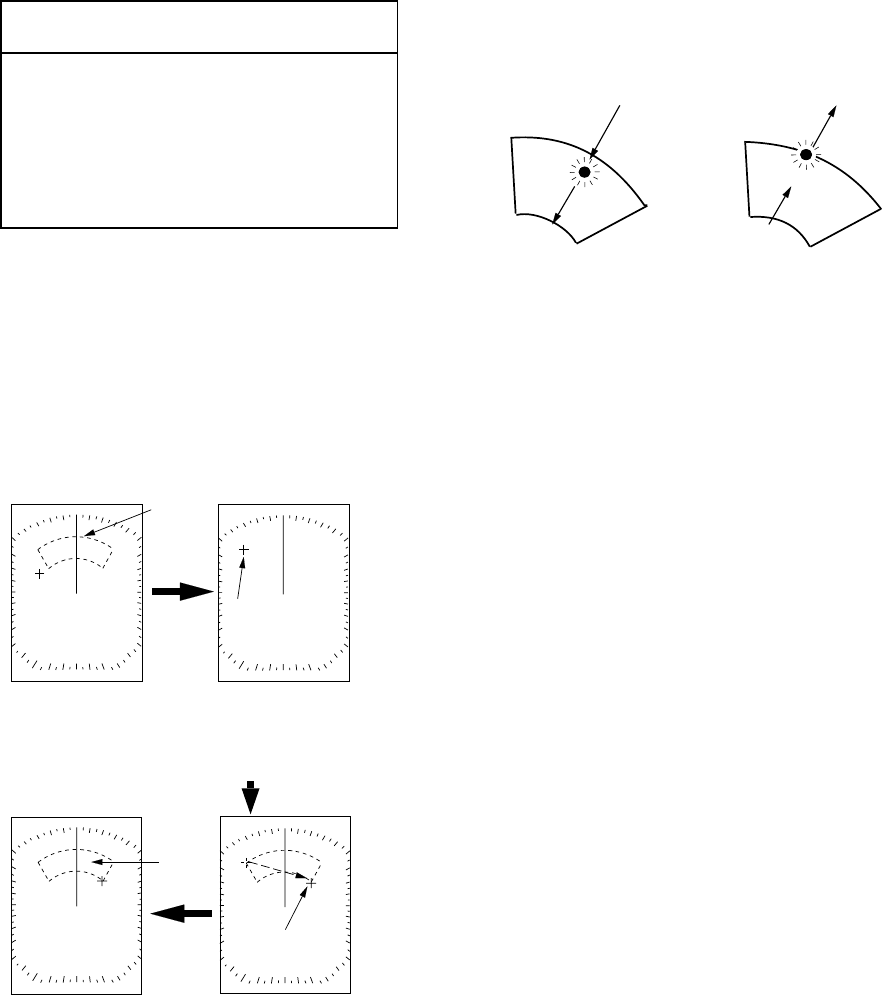
1. OPERATION
11
1.20 Guard Alarm
The guard alarm allows the operator to set
the desired range and bearing for a guard
zone. When ships, islands, landmasses, etc.
violate the guard zone, audio and visual
alarms are released to call your attention.
The alarms will be released for targets
entering or exiting the zone depending on the
presence or absence of targets in the zone
when the alarm is set.
*
The alarm should not be relied upon as the
sole means for detecting possible collision
situations.
*
A/C SEA, A/C RAIN, FTC and GAIN controls
should be properly adjusted to be sure the
weak echoes will not be missed by the alarm.
NOTICE
Setting a guard zone
1. Operate the cursor pad to place the
cursor at the top left corner for the zone
and then press the [ALARM] key.
2. Operate the cursor pad to place the
cursor at the bottom right corner for the
zone and then press the [ALARM] key.
Guard
zone
to set
G(---)
1)Place cursor at
top left corner for
zone and press
[ALARM].
Place cursor
here.
Mentally create
the guard zone
to set.
2)Place cursor at
bottom right corner
for zone and press
[ALARM].
Guard zone
completed.
Guard
zone
Place cursor
here.
G(---)
G(---)
How to set a guard zone
How guard zone type is determined
After the guard zone has been set, the radar
checks for targets inside the guard zone,
which takes about 8 to 12 seconds. When the
check is completed, “G(IN)” or “G(OUT)”
replaces G(---) at the top right corner.
G(IN): When no target exists in the zone,
"G(IN)" appears. The audio alarm sounds
against targets which enter the guard zone.
G(OUT): If there are targets in the guard
zone, "G(OUT)" appears. The audio alarm
sounds against all targets which exit from the
guard zone.
(a) Inward target alarm (b) Outward target alarm
Inward and outward alarms
Note: The guard zone disappears when it is
not within the range in use. When this occurs
"UP RNG" replaces G(IN) or G(OUT).
Change the range to redisplay the guard
zone.
Silencing the audio alarm
When a target violates the guard zone, the
target flashes and the audio alarm sounds.
You can silence the audio alarm with the
[ALARM] key. The target continues flashing
until it no longer violates the guard zone or
the guard zone is canceled.
Canceling the guard zone and guard
alarm
Press and hold down the [ALARM] key until
the guard zone is erased.
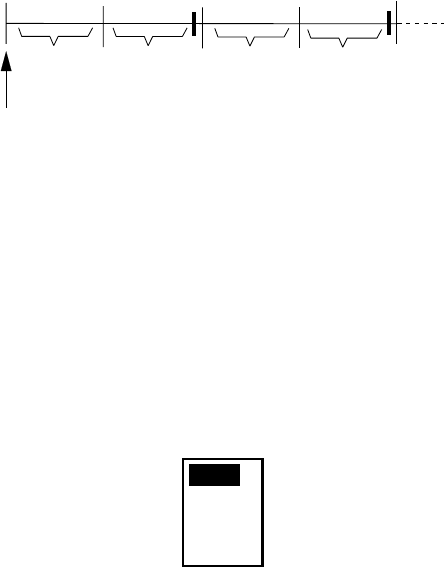
1. OPERATION
12
1.21 Watchman
The radar "wakes up" at specified time
intervals (5, 10, or 20 minutes) and operates
for 10 scans, the start of which is announced
by releasing the audio alarm. If change is
found in the guard zone from the previous 10
scans, the audio alarm sounds and the radar
resumes normal operation, canceling the
watchman mode. If no change is found, the
radar goes into stand-by, for the specified
time interval. This feature is useful for
periodic watch of the guard zone.
ST-BY
5,10
or
20 min
Tx
1 min
Tx
1 min
Watchman
starts
5,10
or
20 min
ST-BY
**
* Beeps emitted just before radar transmits.
How watchman works
1. Set a 360° guard zone referring to
paragraph 1.20.
2. Press the [MENU/ESC] key to open the
User menu.
2. Press ▲ or ▼ to choose WATCHMAN
TIME from page 2.
3. Press ► to open the options window.
OFF
5 min
10 min
20 min
Watchman time options
4. Press ▲ or ▼ to choose appropriate time
out, that is, the amount of time the radar
waits in standby, among 5, 10 and 20
minutes.
5. Press the [MENU/ESC] key to close the
menu.
1.22 Suppressing Long-range
Rain Clutter
In adverse weather, clouds, rain or snow
produce spray-like spurious echoes which
impair target detection over a long distance.
These echoes can be suppressed by turning
on the FTC (Fast Time Constant). FTC works
by splitting up these unwanted echoes into a
speckled pattern, making recognition of solid
targets easier.
1. Press the [MENU/ESC] key.
2. Press ▲ or ▼ to choose FTC from page
1.
3. Press ► to open the options window.
4. Press ▲ or ▼ to choose OFF or ON as
appropriate.
5. Press the [MENU/ESC] key to close the
menu.
“FTC” appears at the top right corner when
the FTC is active.
1.23 Panel Backlighting
You may adjust panel backlighting as follows:
1. Press the [MENU/ESC] key to open the
User menu.
2. Choose PANEL DIMMER from page 2.
3. Press ► to open the options window.
4. Choose OFF, LOW, MEDIUM or HIGH as
appropriate.
5. Press the [MENU/ESC] key to close the
menu.
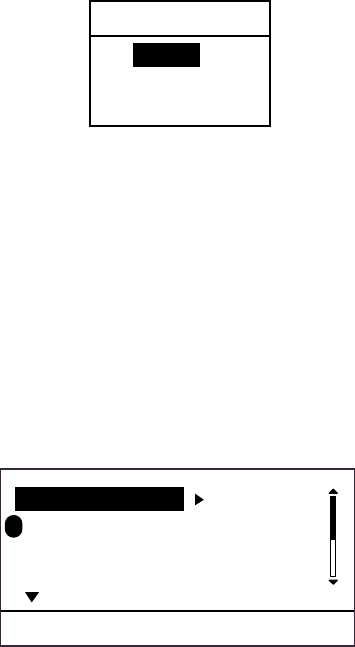
1. OPERATION
13
1.24 Hue
The default hue setting (DAY) displays
echoes in tones of gray on a white
background, which is most suitable for
daytime viewing. For nighttime viewing you
may reverse this arrangement.
1. Press the [MENU/ESC] key to open the
User menu.
2. Press ▲ or ▼ to choose HUE from page
2.
3. Press ► to open the options window.
4. Press ▲ or ▼ to choose DAY or NIGHT
as appropriate.
5. Press the [MENU/ESC] key to close the
menu.
1.25 Resetting Distance Run
You may reset distance run to zero as below.
You need a navigator or speed log to display
distance run.
1. Press the [MENU/ESC] key to open the
User menu.
2. Press ▲ or ▼ to choose “TRIPLOG
RESET?” from page 3.
3. Press ► to open the options window.
4. Press ▲ to choose YES to reset distance
run to zero.
5. Press the [MENU/ESC] key to close the
menu.
1.26 PROG Key
The [PROG] key acts as a shortcut key. You
may use any User menu item except
“TRIPLOG RESET?” and “SYSTEM MENU.”
Using the PROG key
1. Press the [PROG] key. The options
window corresponding to the item
programmed appears. In the example at
the top of the next page the echo stretch
options window is shown.
OFF
LOW
HIGH
ECHO STRETCH
Echo stretch options window
2. Press ▲ or ▼ to choose appropriate
option.
3. Press the [MENU/ESC] key to close the
options window.
Programming the PROG key
1. Press the [MENU/ESC] key to open the
User menu. “P” marks the current function
of the [PROG] key.
P
(1/3)
INT REJECTION LOW
ECHO STRETCH : LOW
FTC : OFF
NOISE REJECTION: LOW
[MENU/ESC] : Exit.
*
User menu, page 1
2. Press ▲ or ▼ to choose the item you
wish to use.
3. Press and hold down the [PROG] key
(about three seconds) until you hear a
beep and the “P” moves to the item
selected.
4. Press the [MENU/ESC] key to close the
menu.
1.27 Outputting Target Position
to a Plotter
If the radar is interfaced with a plotter, you
can output a radar target’s latitude and
longitude position to the plotter, and show
that position on the plotter’s screen, with the
target mark (X). This function requires
position and heading data.
1. Use the cursor pad to place the cursor on
a target.
2. Press the [TLL] key to output the target’s
L/L position.
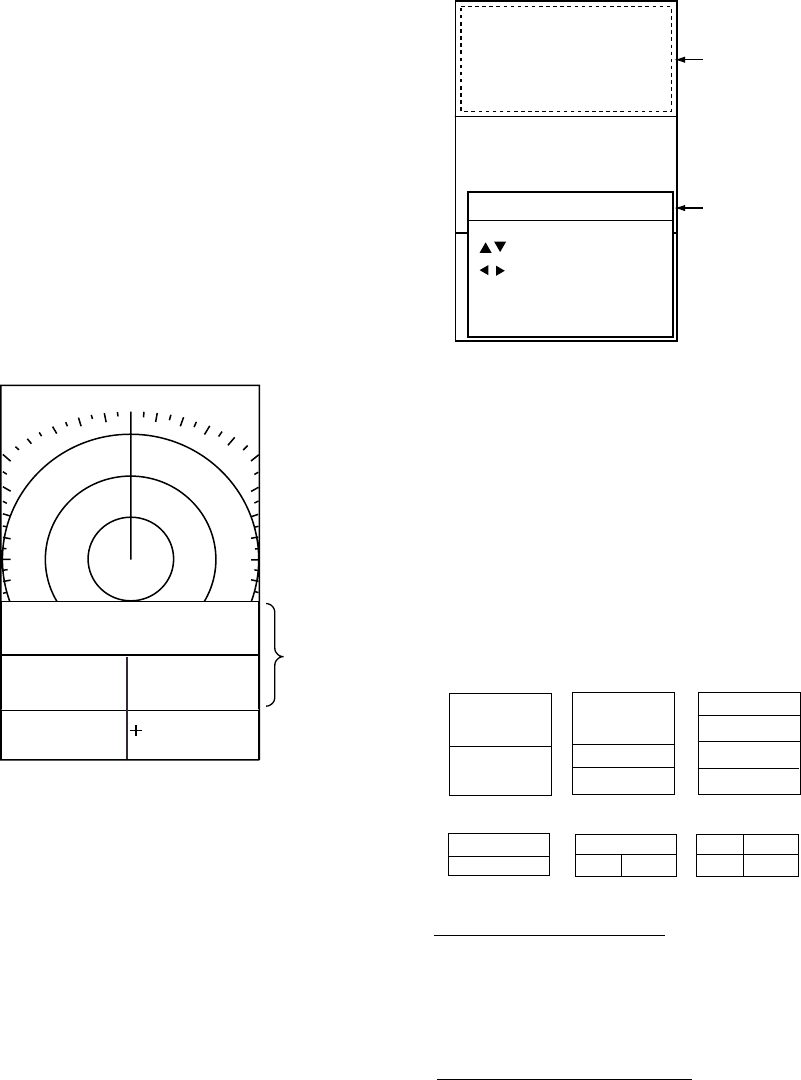
1. OPERATION
14
1.28 Turning Navigation Data
On/Off
Navigation data appears on the bottom half of
the screen as in the illustration below. You
may turn the navigation data display on or off
as shown below.
Note: When the nav data is turned on with
shift or zoom active, zoom or shift is
cancelled.
1. Press the [MODE] key.
2. Press ► to choose ON; ◄ to choose
OFF.
3. Press the [MENU/ESC] key to close the
menu.
6.0 nm
2.0
RNG 2.22nm
BRG 45.62°
TTG 02H21M
+
Position
Nav
Data
34°44.135 N
135°44.135 E
Speed Course
10.2 kt 135°
Position
EBL
- - -
.-
°
VRM - - - -nm
Sample navigation display
1.29 Setting up Nav Data
Displays
The user may arrange the nav data display
as desired. You may display between two and
four items and choose the item and the order
to display them. For how to choose the
number of items to display, see “NAV DATA”
on page 16.
1. Turn on the nav data referring to
paragraph 1.28.
2. Press the [POWER/BRILL] key
momentarily followed by the [MODE] key
to go into stand-by.
3. Press the [MENU/ESC] key to close the
window.
4. Press the cursor pad to display the nav
data setup window.
Position
30°00.065'N
130°00.574'E
DATE
09 10 02
DATE
09 10 02
TIME
14:25:03
0.25nm
XTE
1 0.5 0 0.5 1
Dashed rectangle
circumscribes
selection
NAV DATA SETUP
/ : Window Selection
/ : Data Selection
[MENU/ESC] : Enter
Nav data
setup window
Nav data display with nav data setup window
4. Press ▲ or ▼ to choose the data window
to process. The dashed rectangle
circumscribes current selection.
5. Press ◄ or ► to choose item to display.
See the illustration below for the data
availability. A description of the nav data
displays appears on the next page.
Items displayable in (1) - (3): depth, position,
course, date, time, range and bearing, trip distance,
odometer distance, water temperature,
heading, time-to-go to destination waypoint,
XTE*, speed*, wind speed and direction*,
destination waypoint data*, compass*
(9)
(1)
(2)
(3)
(4)
(5)
(6)
(7)
(8)
(1)
(2)
(3)
(4) (5)
(6) (7)
(8) (9)
Nav data at stand-by
Nav data on radar display
Items displayable in (4) - (9): depth, position,
course, range and bearing, trip distance,
odometer distance, water temperature,
date, time, speed, heading, air pressure, time-to-go
to destination waypoint, XTE, wind speed and direction
* = Graphic display in standby
2-item
display
3-item
display
4-item
display
Nav data window and item displayable
6. Press the [MENU/ESC] key to close the
nav data setup window.
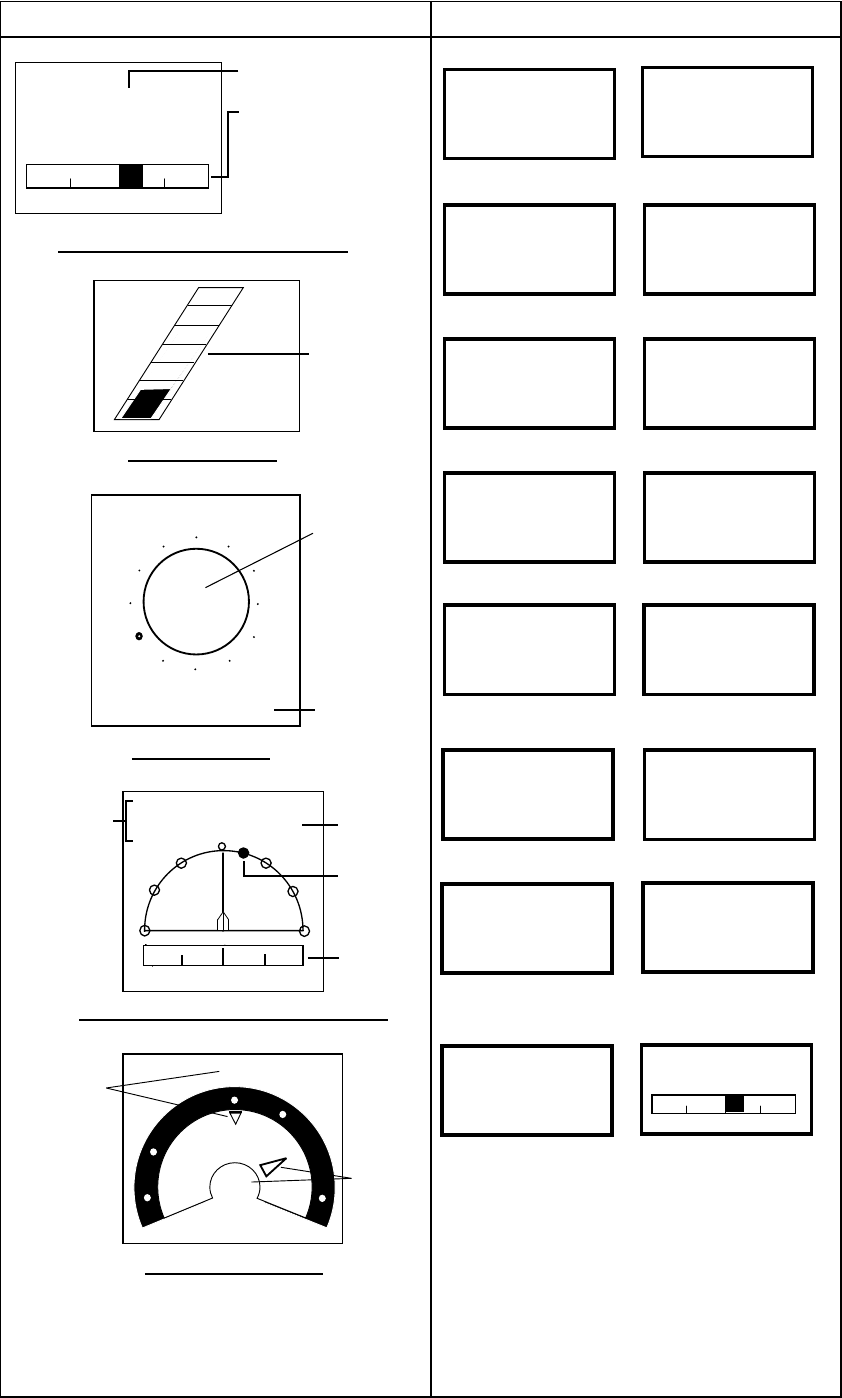
1. OPERATION
15
GRAPHIC DISPLAYS DIGITAL DISPLAYS
1 0.5 0 0.5 1
Waypoint 03
Rng 0.19nm Brg 321°
XTE 0.00nm Cse 333°
DESTINATION WAYPOINT GRAPHIC
XTE
scale
Bearing,
Course
Destination
waypoint
direction
Destination
waypoint
data:
Name,
Range to,
XTE
Wind
APP*
WIND GRAPHIC
60
120
90
030
150
180
120
150
90
60
30
120°
Speed
10.3
m/s
COMPASS GRAPHIC
SPEED GRAPHIC
17.2
Speed
20
50
40
60
30
10
0
Course
123.0°
COURSE
Depth
32.8ft
DEPTH
Heading
MAG#
HEADING
Odometer
56nm
ODOMETER
Position
30°00.065'N
130°00.574'E
POSITION
Temperature
69.8°F
WATER TEMPERATURE
Trip meter
121nm
TRIP DISTANCE
Time to Go
00H30M
TIME-TO-GO**
Speed
19.3kt
SPEED
Range
1.21nm
RANGE & BEARING**
Bearing
140
°
Wind Speed
APP*
WIND SPEED
Wind Direction
APP*
WIND DIRECTION
kt
Bearing to
destination
waypoint
Course
Brg
30°
Cse
90°
N
E
* = APP or TRUE depending on menu
setting. See WIND SPD/DIR on page 17
for description.
** = Range and bearing to destination
waypoint
# = MAG(netic) or TRUE. TRUE requires
heading sensor.
Speedometer
Note: The graphic displays selected on the
standby display are repeated on the radar display.
TD
31234.5
56432.6
LORAN C/DECCA TIME
DIFFERENCES
TIME
Time
14:25:03
Wind
direction
Wind speed
XTE (Cross-Track Error) GRAPHIC
1 0.5 0 0.5 1
0.25
nm
XTE
Digital XTE
Analog XTE
(Bar moves right
or left according
to amount and
direction of XTE)
318°
8.0m/s
138°
Date
XTE
CROSS-TRACK ERROR
2002 SEP 19
DATE
0.24
nm
1 0.5 0 0.5 1
Nav data displays
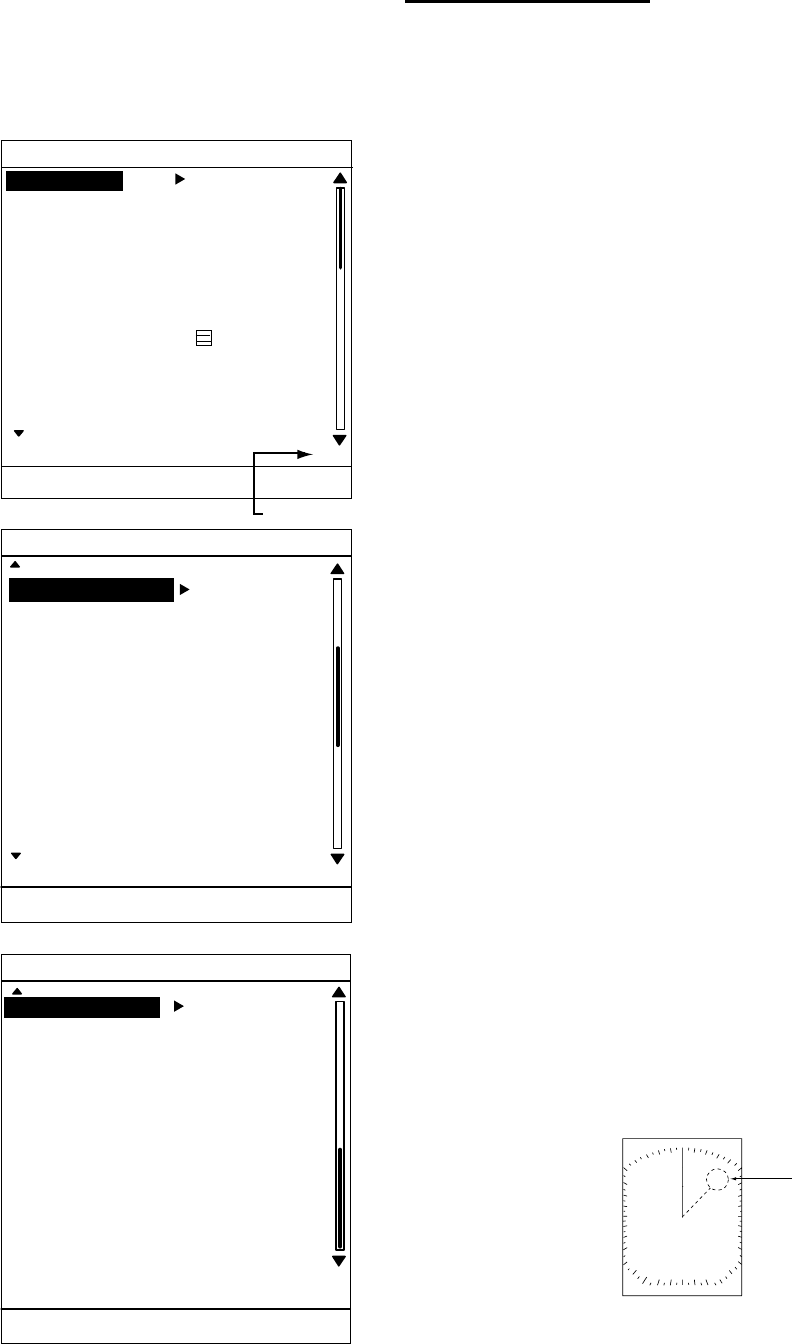
1. OPERATION
16
1.30 System Menu
The System menu mainly contains items
which once set do not require frequent
adjustment. You may display this menu by
choosing “SYSTEM MENU” from page 3 of
the User menu and then pressing ►.
SYSTEM MENU
LANGUAGE English
RANGE UNIT : nm
DEPTH UNIT : ft
SPEED UNIT : kt
WIND UNIT : kt
TEMP UNIT : °F
NAV DATA :
KEY BEEP : ON
RINGS : OFF
WAYPOINT MARK : OFF
(1/3)
[MENU/ESC] : Exit.
SYSTEM MENU
(2/3)
[MENU/ESC] : Exit.
SYSTEM MENU
(3/3)
RANGE 0.125nm ON
0.25 nm : ON
0.5 nm : ON
0.75 nm : ON
1 nm : OFF
1.5 nm : ON
2 nm : OFF
3 nm : ON
4 nm : OFF
6 nm : ON
8 nm : ON
12 nm : ON
16 nm : ON
24 nm : ON
[MENU/ESC] : Exit.
PAGE 3
PAGE 2
PAGE 1
Page no.
EBL REFERENCE TRUE
BEARING READOUT : TRUE
CURSOR POSITION : RNG&BRG
TRIP SOURCE : LAT/LON
WIND SPD/DIR : APPARENT
SHIFT MODE : MANUAL
AUTO SHIFT SPEED : 15
TX SECTOR BLANK : OFF
BLANKING START : 000°
BLANKING AREA : 000°
LOCAL TIME SETUP : +0:00
ANTENNA SPEED : AUTO
System menu
System menu description
Page 1 of system menu
LANGUAGE: The system language is
available in English, several European
languages and Japanese. To change the
language, choose language desired, and then
press the [MENU/ESC] key.
RANGE UNIT: Chooses the unit of range
measurement among nautical miles,
kilometers and statute miles.
DEPTH UNIT: Chooses the unit of depth
measurement among meters, feet, fathoms,
Hiro (Japanese) and Passi/Braza. Requires
depth data.
SPEED UNIT: Chooses the unit of speed
measurement among knot, mile per hour and
kilometer per hour. Requires speed data.
WIND UNIT: Chooses the unit of wind
measurement among mile per hour, kilometer
per hour and meters per second. Requires
wind data.
TEMP UNIT: Chooses the unit of water
temperature measurement from Celsius and
Fahrenheit. Requires water temperature data.
NAV DATA: Chooses the amount of nav data
to display among two, three and four items.
Requires appropriate sensors.
KEY BEEP: A beep sounds to confirm valid
and invalid operation. You can turn this beep
on or off.
RINGS: Turns the range rings on or off.
WAYPOINT MARK:
The waypoint mark
shows the location
of the destination
waypoint set on a
plotter. You can turn
this mark on or off.
Requires a plotter. Waypoint mark
Waypoint
mark

1. OPERATION
17
Page 2 of system menu
EBL REFERENCE: The EBL readout may be
chosen from relative (relative to own ship’s
heading) or true (referenced to the North).
Heading data required for true bearing.
Note: If no bearing data is input, course data
from the GPS navigator is used. In this case
ship’s speed must be more than two knots.
BEARING READOUT: Course indication may
be shown in true or magnetic (magnetic
compass) degrees. Heading data required for
true degrees.
CURSOR POSITION: Chooses the
information to show for the cursor position:
latitude and longitude or range and bearing
from own ship. Latitude and longitude
position requires a navigator.
TRIP SOURCE: Chooses the criteria for
calculating distance run: latitude and
longitude or speed. Requires navigator or
speed log.
WIND SPD/DIR: True is the speed and
direction (in relation to ship’s bow) of the wind
felt or measured when stationary. Apparent
is the direction (in relation to ship’s bow) and
speed of the wind as it appears to those on
board, relative to the speed and direction of
the boat; combination of the true wind and the
wind caused by the boat’s movement.
Requires wind data.
SHIFT MODE: Own ship position, or sweep
origin, can be displaced manually or
automatically. For automatic displacement,
the amount of shift is calculated with ship
speed, and the amount is limited to 60% of
the range in use. For example, if the “Auto
Shift Speed” setting is 15 knots and the ship
is running at 10 knots, the amount of shift will
be about 40%. The formula for determining
shift amount is as below. Requires speed
data.
Ship’s speed
Shift speed setting X 0.6 = Amount of shift(%)
AUTO SHIFT SPEED: Sets the automatic
shift maximum speed. The setting range is
1-99.
TX SECTOR BLANK: In some installations it
may be unavoidable to locate the antenna
where an object (mast, etc.) will prevent
transmission within its breadth. You should
disable transmission within this area by
turning on this feature and setting the area
with BLANKING START and BLANKING
AREA below.
BLANKING START: Sets the starting point
(000-359°) of the TX sector blanking area.
BLANKING AREA: Sets the end point of the
TX sector blanking area (000-135°).
LOCAL TIME SETUP: Enter time difference
between local time and UTC time to use local
time. Press ▲ or ▼ to set value.
ANTENNA SPEED: Chooses antenna
rotation speed from 24 rpm and AUTO. Use
AUTO to automatically change the antenna
rotation speed (24-41 rpm) according to pulse
length*. Choose “24 rpm” to rotate the
antenna at 24 rpm regardless of pulse length.
* = Short pulse at high rotation speed; long
pulse at slow rotation speed.
Page 3 of system menu
RANGE: Chooses the ranges to use.

18
2. MAINTENANCE, TROUBLESHOOTING
WARNING
ELECTRICAL SHOCK HAZARD
Do not open the equipment.
Only qualified personnel
should work inside the
equipment.
2.1 Maintenance
Regular maintenance is important for good performance. A maintenance program should be
established and should at least include the items listed in the table below.
Maintenance program
Period Item Check point Action
Fixing bolts for
antenna unit
Check for corrosion and if
tightly fastened.
Replace corroded bolts. Coat new
bolts with anticorrosive sealant.
Antenna unit
cleanliness
Check for foreign material.
(Foreign material on the
antenna unit can cause a
considerable drop in
sensitivity.)
Clean the antenna unit with a
freshwater-moistened cloth.
Alcohol may be used. Do not use
commercial cleaners to clean the
antenna unit; they can remove
paint and markings or deform the
equipment.
Antenna unit
cover
Check for cracks. Permanent
damage to the unit’s circuitry
will result if water leaks inside.
If a crack is found, it should be
temporarily repaired by using a
small amount of sealing compound
or adhesive. The unit should then
be brought to your dealer for
permanent repairs.
3 to 6
months
Display unit
case, LCD
The display case and LCD will,
in time, accumulate a coating
of dust, and dust on the LCD
tends to dim the picture.
Wipe the LCD carefully to prevent
scratching, using tissue paper and
an LCD cleaner. To remove dirt or
salt deposits, use an LCD cleaner,
wiping slowly with tissue paper so
as to dissolve the dirt or salt.
Change paper frequently so the
salt or dirt will not scratch the LCD.
Do not use commercial cleaners to
clean the display unit; they can
remove paint and markings or
deform the equipment.
6 months
to 1 year
Display unit
connectors
Check for tight connection and
corrosion.
If corroded, ask your dealer about
replacement.

2. MAINTENANCE, TROUBLESHOOTING
19
2.2 Replacing the Fuse
The fuse (5 A) in the power cable protects the equipment against reverse polarity of the ship’s
mains, overcurrent, and equipment fault. If the fuse blows, find the cause before replacing it.
Use the proper fuse.
Use of a wrong fuse may cause
serious damage to the equipment
and void the warranty.
CAUTION
2.3 Troubleshooting
The table below provides simple troubleshooting procedures which the user can follow to
restore normal operation. If you cannot restore normal operation contact your dealer for advice.
Troubleshooting
If… But… Then…
nothing appears on the display
or display contrast is poor
•
try adjusting LCD contrast.
•
battery may have
discharged; check battery.
•
check if fuse has blown.
you pressed the
[POWER/BRILL] key to turn on
the radar
the control panel does not light adjust PANEL DIMMER on the
User menu.
the message “NO HEADING
PULSE” or “NO BEARING
PULSE” appears
check that the antenna cable is
firmly connected.
the radar has warmed up and
you pressed the [MODE] key
to transmit
neither noise or targets appear
(characters and markers do)
•
try adjusting gain, A/C SEA
and A/C RAIN.
•
check antenna cable for
damage.
a key is pressed nothing happens key may be faulty. Contact
your dealer.
the display freezes press the [POWER/BRILL] key
about five seconds to turn off
the power and then turn it on
again.
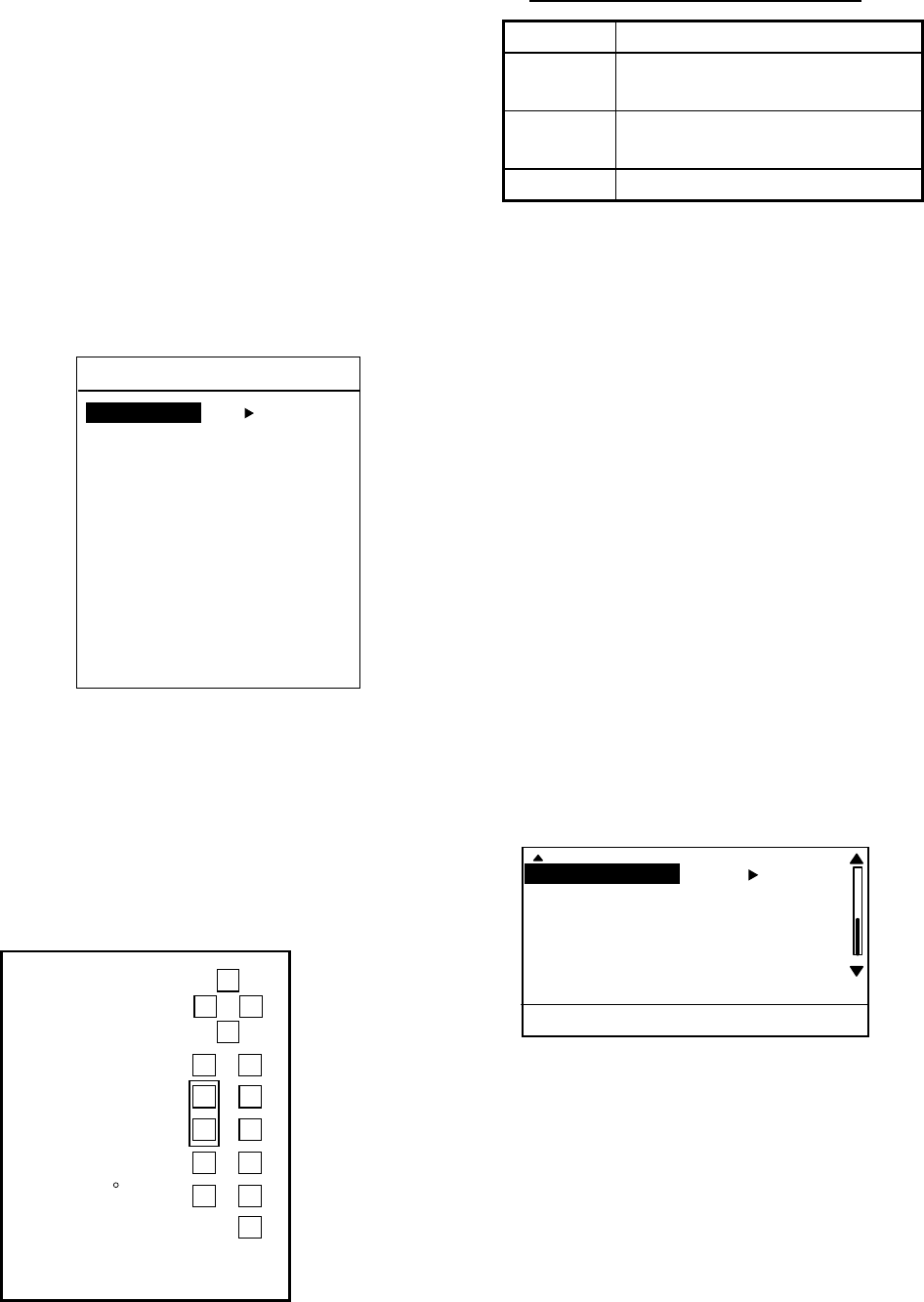
2. MAINTENANCE, TROUBLESHOOTING
20
2.4 Diagnostics
If you feel that your unit is not working
properly, conduct the appropriate diagnostic
test, display unit or antenna unit, to find the
possible cause. If you cannot restore normal
operation, contact your dealer for advice.
Display unit
1. Turn on the power while pressing and
holding down the [MENU/ESC] key.
Continue pressing the [MENU/ESC] key
until the Installation menu appears.
SIMULATION OFF
TEST ...
LCD PATTERN ...
MEMORY CLEAR
NMEA PORT : IN/OUT
NMEA OUTPUT : OFF
GPS WAAS : OFF
GOTO RADAR SETUP...
INSTALLATION MENU
*
* The simulation provides internally
generated echoes, for use in
exhibitions, etc. "SIM" appears
at the top left corner when the
simulation mode is active.
Installation menu
2. Press ▼ to choose TEST.
3. Press ► to start the test. In a few
moments the results will appear.
ROM OK
RAM OK
NMEA 01
Body: 39 C
Program No. 0359199-**.**
Push [MENU] 3 times to exit.
* Program no. of FURUNO BlackBox GPS
**.** = Program version no.
GPS (XXXXXXX-XX.XX): OK*
Diagnostic test results
Interpreting display unit test results
Item Results
ROM,
RAM
OK: Normal
NG: No Good
NMEA Test connector required to test.
Normally, “01” is displayed.
Body Temperature of display unit
4. The squares at the right side of the test
results display are for checking controls.
Press each key and the arrows on the
cursor pad one by one. A control’s
corresponding on-screen square “lights” in
black if the control is working properly.
5. To return to the Installation menu, press
the [MENU/ESC] key three times.
6. To restore normal operation, turn off the
power and then turn it on again.
Antenna unit
1. Display the installation menu as in step 1
in the display unit diagnostic test.
2. Press ▼ to choose GOTO RADAR
SETUP and then press ►. Power is
automatically reset.
3. Press the [POWER/BRILL] and [MODE]
keys to transmit.
4. Press the [MENU/ESC] key. The menu
below appears.
(4/4)
RADAR SETUP
SCANNER TEST ...
[MENU/ESC]: Exit.
Page 4/4 of user menu
5. Press ▼ to choose SCANNER TEST.
6. Press ► to start the test. In a few
moments the results will appear, similar to
those shown at the top of the next page.
7. To restore normal operation, turn off the
power and then turn it on again.
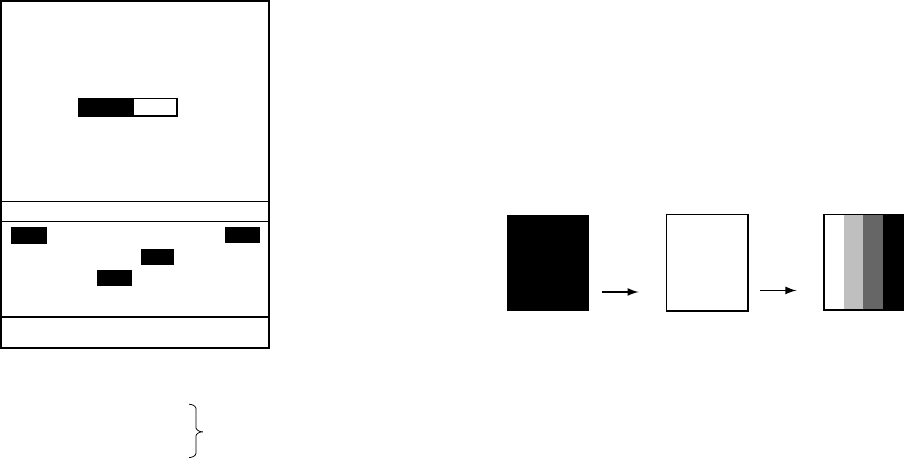
2. MAINTENANCE, TROUBLESHOOTING
21
ANTENNA STATUS : OK(47)#
HEADING : OK
BEARING : OK
(24.0rpm)*
TUNE :
TOTAL ON TIME : 00000h
TOTAL TX TIME : 00000h
INPUT NMEA
RMA RMB RMC BWC GLL GGA
MTW VTG VHW XTE VBW DPT
DBK DBS DBT HDT HDG HDM
BWR GLC GTD MWV ZDA
# Numeric is status code. For service technician.
* Antenna rotation speed
24.0 = Long range
31.0 = Medium range
41.0 = Short range
typical
value
[MENU/ESC]: Exit.
Antenna test results
The antenna unit and heading and bearing
signals are checked, and the results shown
as OK or NG (No Good). For any NG, contact
your dealer for advice. Antenna unit RPM
appears below the bearing signal test result.
Note: The result of ANTENNA STATUS is
shown as “NG (0)” when the antenna test
result screen is initially shown. To confirm the
antenna status, press the [MENU/ESC] key
and ►.
The “TUNE” bar shows radar receiver tuning
status. Total on time and total TX times
appear below the TUNE bar. Data sentences
currently input to the radar are highlighted in
the “INPUT NMEA” window.
2.5 Test Pattern
This feature tests for proper display of tones.
1. Turn on the power while pressing and
holding down the [MENU/ESC] key.
Continue pressing the [MENU/ESC] key
until the Installation menu appears.
2. Press ▼ to choose LCD PATTERN.
3. Press ► to start the test. The entire
screen is black.
4. Press the [MENU/ESC] key and the
screen turns white.
5. Press the [MENU/ESC] key again and the
screen shows a four-tone display.
6. Press the [MENU/ESC] key again to
return to the Installation menu.
7. To restore normal operation, turn off the
power and then turn it on again.
WHITE FOUR-TONE
BLACK
Press
[MENU/
ESC].
Press
[MENU/
ESC].
Test patterns
2.6 Clearing the Memory
You may want to clear the memory to start
afresh with default settings. You can do this
as follows:
1. Turn on the power while pressing and
holding down the [MENU/ESC] key.
Continue pressing the [MENU/ESC] key
until the Installation menu appears.
2. Press ▼ to choose MEMORY CLEAR.
3. Press ►.
4. Press ▲ to choose YES.
5. To restore normal operation, turn the
power off and then turn it on again.
2.7 Replacing the Magnetron
When the magnetron has expired, distant
targets cannot be seen on the display. When
you feel that long range performance has
decreased, contact a FURUNO agent or
dealer about replacement of the magnetron.
(Type: E3588, Code No: 000-142-270)
2.8 Replacing the Synchro
Belt
When the synchro belt has worn out, the
sweep is not synchronized with antenna
rotation, which results in an abnormal picture.
When you suspect that the synchro belt has
worn out, contact a FURUNO agent or dealer
about replacement. (Type: 40 S2M 266UG,
Code No: 000-808-743)
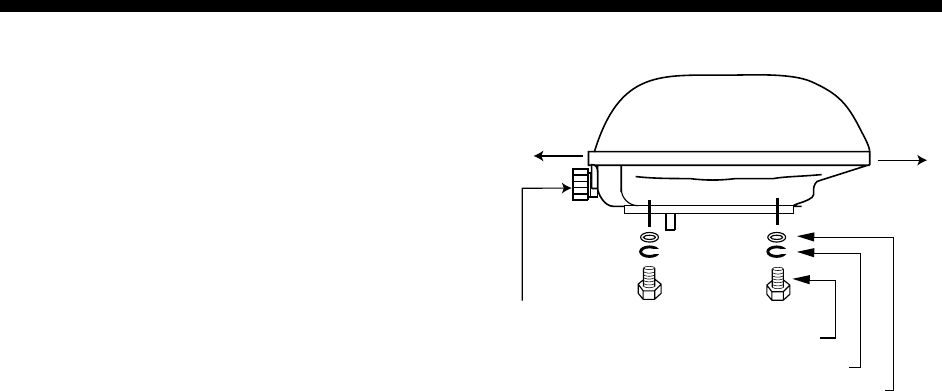
22
3. INSTALLATION
3.1 Antenna Unit Installation
Mounting considerations
When choosing a mounting location for the
antenna unit, keep in mind the following
points:
•
Install the antenna unit on the hardtop,
radar arch or on a mast on an appropriate
platform. (For sailboats, a mounting bracket
is optionally available.) It should be placed
where there is a good all-round view with,
as far as possible, no part of the ship’s
superstructure or rigging intercepting the
scanning beam. Any obstruction will cause
shadow and blind sectors.
•
In order to minimize the chance of picking
up electrical interference, avoid where
possible routing the antenna cable near
other electrical equipment onboard. Also,
avoid running the cable in parallel with
power cables.
•
Separate the antenna unit from a magnetic
compass by the distances noted below to
prevent interference to the magnetic
compass:
Standard compass: 1.25 m
Steering compass: 0.85 m
Mounting on a platform
1. Remove mounting hardware at the bottom
of the antenna unit; four each of hex bolts
(M10X20), spring washers and flat
washers. Save mounting hardware to use
it to fix the antenna unit to the mounting
platform later on.
Flat washer
Spring washer
Hex bolt (M10 x 20)
Bow
Stern
Cable gland
Antenna unit, showing location of
mounting hardware
2. Construct a platform (wood, steel, or
aluminum) of 5-10 mm in thickness
referring to the outline drawing at back of
this manual. Fasten the platform to the
mounting location. Next, position the
antenna unit so the cable gland faces
toward boat’s stern.
Note 1: If corrosive material is used for
the platform, take appropriate
anticorrosive measures to prevent
corrosion.
Note 2: When drilling holes in the platform,
be sure they are parallel with the fore and
aft line.
3. Using the hex bolts, flat washers and
spring washers removed at step 1, fasten
the antenna unit to the platform. The
torque should be between 19.6-24.5
N/
//
/m.
Note: Longer hex bolts (M10 x 25) are
supplied with the installation materials.
Use them instead of the hex bolts
removed earlier if the thickness of the
mounting platform is 5-10 mm.
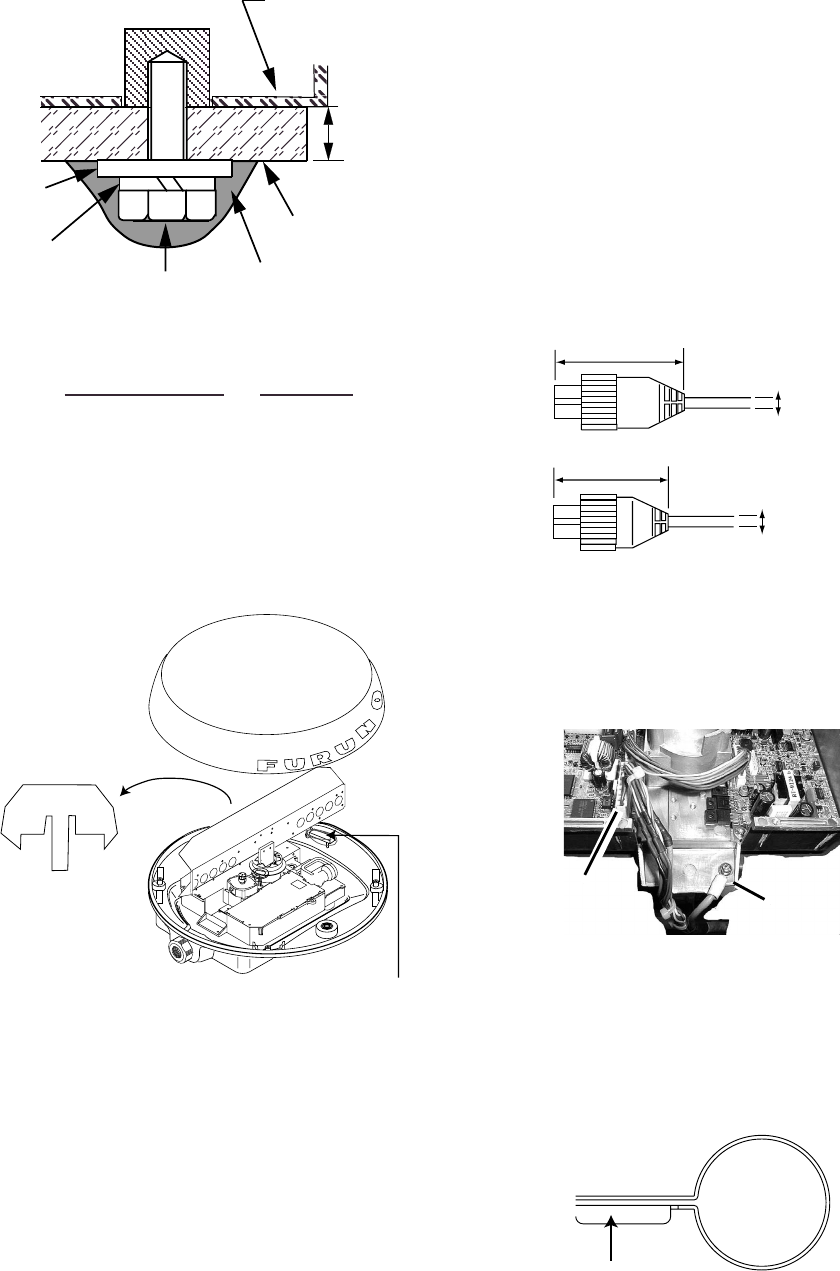
3. INSTALLATION
23
Flat
washer
Antenna base
assy.
Spring
washer
Platform
Hex bolt
(M10 x 25
or M10 x 20)
Apply silicone
sealant.
Platform thickness Bolt to use
5 mm or under: M10x20
5-10mm: M10x25
over 10 mm: locally supplied bolts
*1
*1:
How to fasten the antenna base to platform
4. Unfasten four screws to open the cover.
Remove and discard the packing material
inside the radome.
Remove and
discard the
packing material.
Snap holder
Antenna unit, inside view
The antenna base is fitted with a snap holder,
which may be used to hang the cover after
removal. Use the hole next to the screw hole
inside the cover to hang it.
a) Unfasten the snap assy. with the string
attached at the holder in the antenna
base.
b) Unwind the string.
c) Attach the snap to the screw hole on the
inside of the cover.
Note: Do not use the snap holder to hang
objects other than the cover.
5. Release the cable of the rotation detector
from the cable clamp.
6. Unfasten 11 screws to dismount the shield
plate.
7. Pass the antenna cable with connector
through the gasket and cable clamp, and
then tighten the cable gland. Two gaskets
are supplied: one gray, one black. Use the
proper gasket according to antenna cable
used, referring to the illustration below.
67
φ
12
Use gray gasket.
49
φ
11
Use black gasket.
Antenna unit, top view
8. Referring to the figure below, fasten the
shield cable with a screw (M4 x 10) on the
chassis to ground the unit.
Connect 9 pin
connector
here (J801).
Connect
shield here.
How to connect the antenna cable
to the antenna unit
9. Attach the EMI core to the antenna cable.
Set the EMI core fixing plate to the EMI
core.
Pass the cable through the plate
so the bend faces downward.
EMI core fixing plate
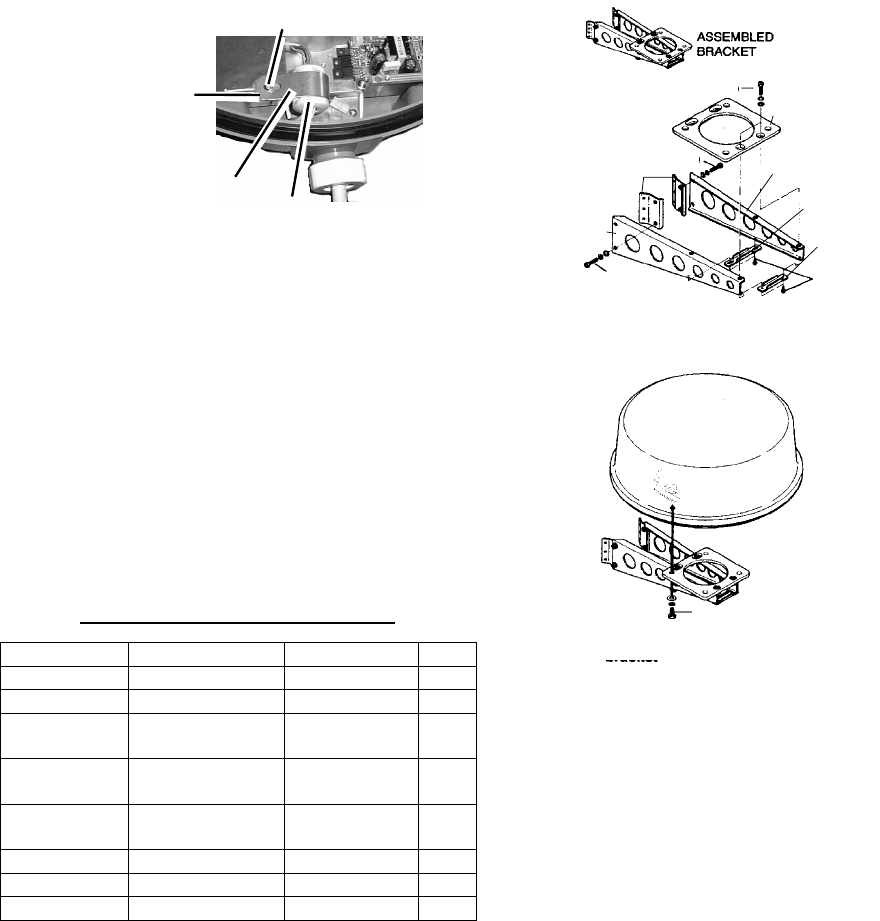
3. INSTALLATION
24
10. Connect the 9-pin connector of the
antenna cable to J801. See the illustration
on the previous page for location.
11. Refasten the shield plate with 10 screws.
Be sure not to pinch the cable from the
rotation detector with the shield plate.
12. Fasten the EMI core fixing plate with
screw (supplied).
Screw (M4 x 15)
EMI Core
EMI Core
Fixing Plate
Align bend with
corner of chassis.
How to fix the EMI core
13. Temporarily close the cover. You will need
to open the cover later to confirm
magnetron voltage.
Mounting using the optional mounting
bracket
A mounting bracket for fastening the antenna
unit to a mast (70-125 mm diameter) on a
sailboat is optionally available.
Type OP03-93, Code 008-445-080
Contents of mounting bracket kit
Name Type Code No. Qty
Bolt M4 x 12 000-804-725 4
Bolt M8 x 20 000-805-707 8
Mounting
plate 03-018-9001-0 100-206-740 1
Support
plate (1) 03-018-9005-0 100-206-780 1
Support
plate (2) 03-018-9006-0 100-206-790 1
Bracket (1) 03-028-9101-0 100-206-810 1
Bracket (2) 03-028-9102-0 100-206-820 1
Fixing plate 03-028-9103-0 100-206-830 2
1. Remove mounting hardware at the
bottom of the antenna base. You may
discard the mounting hardware.
2. Assemble the mounting bracket as below
and fasten it to a mast.
3. Fasten the antenna unit to the mounting
bracket with hexagon head bolts (M10 x
25, optional supply).
Mounting plate
Support
plate (1)
Support
plate (2)
Bracket (1)
Bracket (2)
Fixing plate
M8 x 20
M8 x 20
(A) Assembling the mounting bracket
M4 x 12
(B) Fastening antenna to mounting bracket
M10 x 25
M8 x 20
How to assemble the optional mounting
bracket and mount the antenna
4. Open the cover.
5. Follow steps 5-12 in “Mounting on a
platform.”
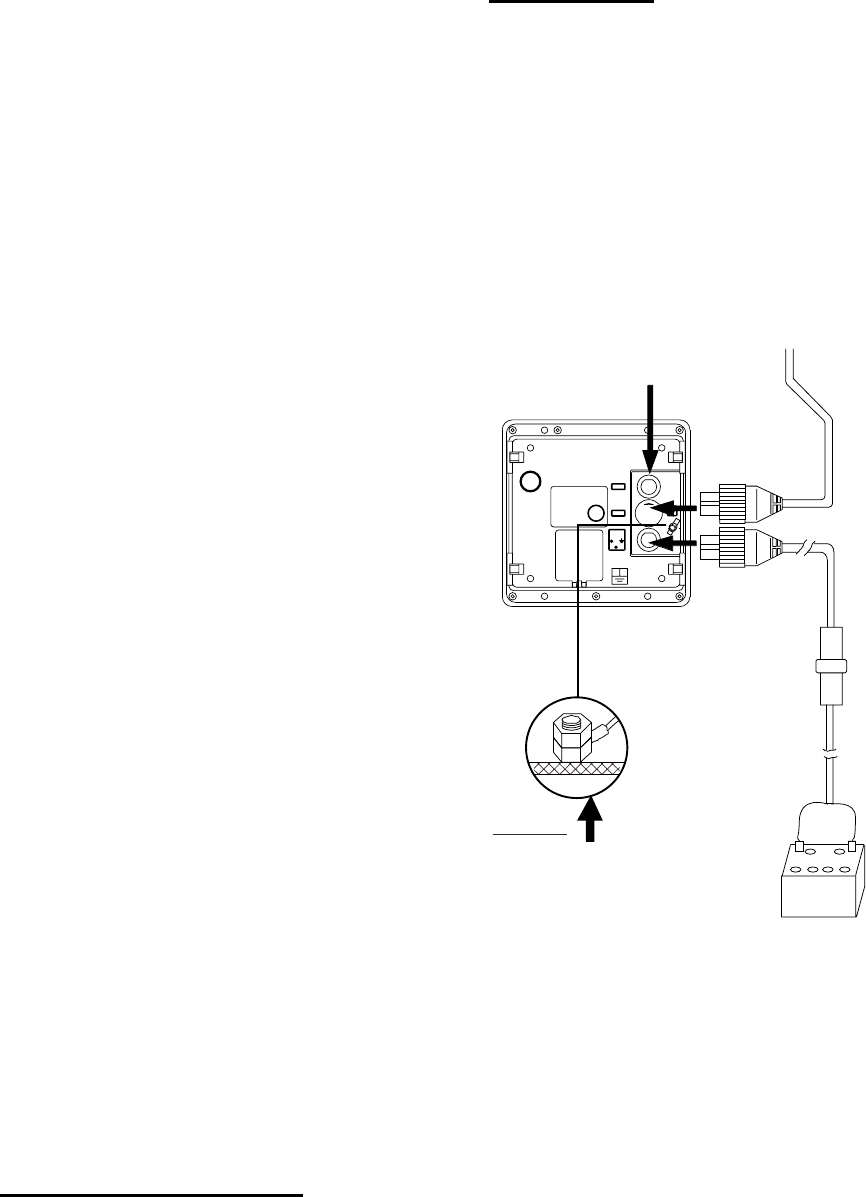
3. INSTALLATION
25
3.2 Display Unit Installation
Mounting considerations
When choosing a mounting location for the
display unit, keep in mind the following points:
•
Keep the display unit out of direct sunlight.
•
The temperature and humidity should be
moderate and stable.
•
Locate the unit away from exhaust pipes
and vents.
•
The mounting location should be well
ventilated.
•
Mount the unit where shock and vibration
are minimal.
•
Keep the unit away from electromagnetic
field-generating equipment such as motors
and generators.
•
For maintenance and checking purposes,
leave sufficient space at the sides and rear
of the unit and leave slack in cables.
•
Separate the display unit from a magnetic
compass unit by the distances noted below
to prevent interference to the magnetic
compass:
Standard compass: 0.6 m
Steering compass: 0.4 m
•
Be sure the mounting location is strong
enough to support the weight of the unit
under the continued vibration normally
experienced on the boat.
Mounting
The display unit can be mounted on a
desktop or overhead or flush mounted in a
console.
Desktop, overhead mounting
1. Fix the hanger to the mounting location
with four tapping screws (supplied).
2. Fit the knob bolts to the display unit.
3. Set the display unit to the hanger.
4. Tighten the knob bolts securely.
Flush mounting
Cutout a hole in the mounting area, referring
to the outline drawing at the back of this
manual for dimensions. Fasten the display
unit with four screws (M4 x 20, supplied).
3.3 Wiring
Connect the antenna cable, the power cable
and the ground wire as shown below.
FUSE (5 A)
POWER SUPPLY
12/24 VDC
POWER CABLE
DISPLAY UNIT
ANTENNA UNIT
ANTENNA CABLE*
WHT (+) BLK (-)
External Equipment
(NMEA)
GROUND
Connect ground
wire to bolt fastened
(or welded) to hull.
* = Do not confuse the
antenna cable with the
transducer cable
for the Echo Sounder
(ex. LS-6100). The transducer
cable is black; the antenna
cable is white and "RADAR"
is written on the cable.
DJ-1
DJ-1
NMEA
NMEA
2
2
3
3
1
1
POWER
POWER
12-24 VDC
12-24 VDC
Wiring
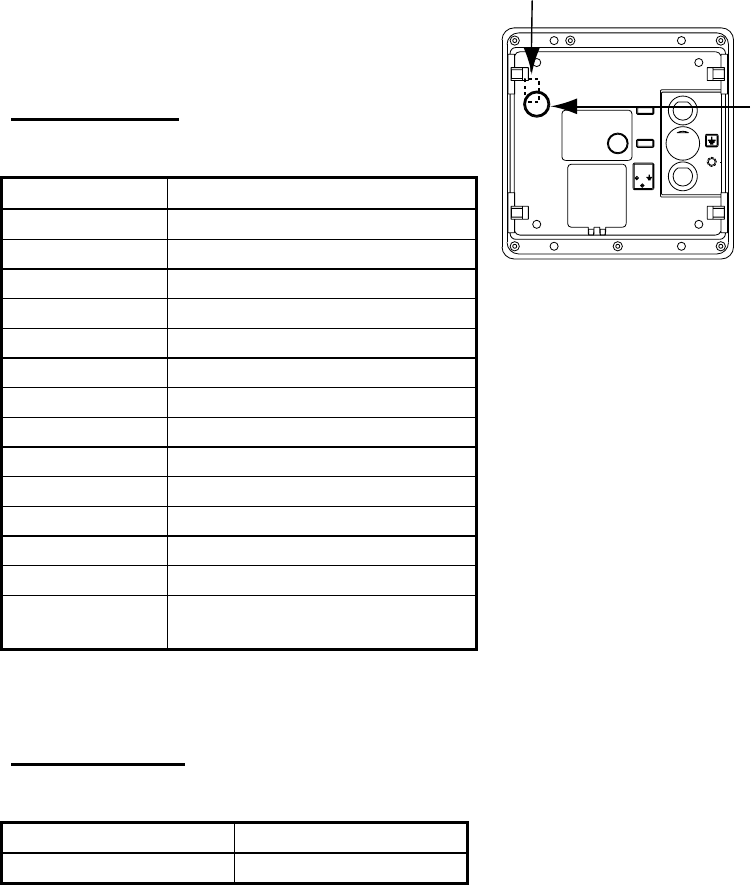
3. INSTALLATION
26
Connecting external equipment
A video sounder, navigator, plotter, wind
indicator or GPS receiver GP-310 (320B) can
be connected to the display unit. You will
need an NMEA cable to make the connection.
To connect two navigators, use the optional
cable MJ-A15A7F0004-005. Connect them
referring to the interconnection diagram at the
back of this manual.
Input sentences
NMEA 0183 Version 1.5/2.0/3.0, 4800 bps
Name Sentences
Ship’s Speed VTG>RMC>RMA>VBW>VHW
Depth DPT>DBK>DBS>DBT
Heading (T)* HDT>HDG>VHW>HDM
Heading (M) HDM>HDG>VHW>HDT
Course (T) VTG>RMC>RMA
Course (M) VTG>RMC>RMA
Range/Bearing RMB>BWR>BWC
Waypoint RMB>BWR>BWC
Own Ship Pos. GGA>RMC>RMA>GLL
Time Diff. RMA>GLC>GTD
Water Temp. MTW
Time, Date ZDA>RMC
Wind Data MWV
Cross-track
Error
RMB>XTE
*Requires magnetic variation (output by
navigator).
Output sentence
NMEA 0183 Version 3.0, 4800 bps
Name Sentence
Target L/L TLL
Connecting the external buzzer
The optional external buzzer (type
XH3-BZ-L970, code no. 000-146-422) sounds
the alarm buzzer in a remove location.
Note: This procedure requires making a hole
in the display unit, which can affect
watertightness. FURUNO cannot guarantee
watertight integrity after this modification is
made.
1. Detach the rear panel and place it out
side up on a workbench.
2. Use a hammer and a Philips head
screwdriver to punch out a hole of ø16 at
the location shown in the illustration
below.
Make a hole of φ16.
Seal hole with sealing
compound after
connecting cable.
Connect cable
to J6 on DU Board.
DJ-1
DJ-1
NMEA
NMEA
2
2
3
3
1
1
POWER
POWER
12-24 VDC
12-24 VDC
Display unit, rear view
3. Close the rear panel, making sure the
gasket is correctly positioned.
4. Plug in the connector of the external
buzzer to J6 on the DU Board.
5. Seal the hole with sealing compound.
6. Fix the buzzer to the location desired with
two tapping screws.
3.4 Adjustments
After you have installed the radar, do the
heading alignment and timing adjustment. If
you are connecting external equipment,
follow “NMEA port setup, GPS WAAS setup”
(for GP-320B) also.
Heading alignment
You have mounted the antenna unit facing
straight ahead in the direction of the bow.
Therefore, a small but conspicuous target
dead ahead visually should appear on the
heading line (zero degrees).
In practice, you will probably observe some
small error on the display because of the
difficulty in achieving accurate initial
positioning of the antenna unit. The following
adjustment will compensate for this error.
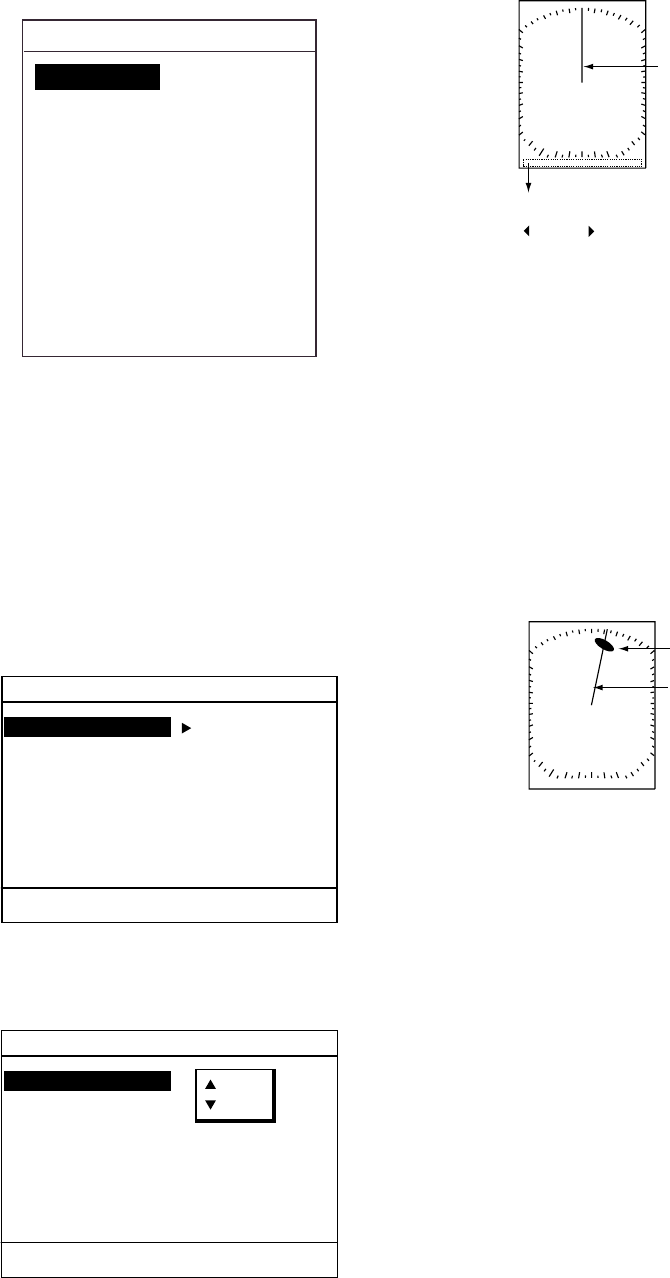
3. INSTALLATION
27
1. Turn on the power while pressing and
holding down the [MENU/ESC] key.
Continue pressing the [MENU/ESC] key
until the Installation menu appears.
INSTALLATION MENU
▲
SIMULATION OFF
TEST...
LCD PATTERN...
MEMORY CLEAR
NMEA PORT : IN/OUT
NMEA OUTPUT : OFF
GPS WASS : OFF
GO TO RADAR SETUP...
Installation menu
2. Press ▼ to choose GOTO RADAR
SETUP.
3. Press ►. Power is then reset.
4. Wait one minute, press the
[POWER/BRILL] key followed by the
[MODE] key to transmit.
5. Press the [MENU/ESC] key to show the
User menu.
6. Press ► to show the Radar Setup menu.
RADAR SETUP
HEADING ADJUST
TIMING ADJUST
SET ON TIME : 000000h
SET TX TIME : 000000h
[MENU/ESC]: Exit.
Radar setup menu
7. HEADING ADJUST is selected; press ►
to show the options window.
RADAR SETUP
HEADING ADJUST
TIMING ADJUST
SET ON TIME : 000000h
SET TX TIME : 000000h
[MENU/ESC]: Exit.
: YES
: NO
Radar setup menu (heading adjust)
8. Press ▲ to choose YES, and the display
now looks as below.
HEADING LINE ADJUSTMENT BY
’ ’ AND ’ ’ KEYS.
THEN PUSH MODE KEY TO SET.
Heading Line
Message
Heading adjustment display
9. Visually identify a suitable target (for
example, ship or buoy) at a range
between 0.125 to 0.25 miles.
10. Point your boat’s bow directly toward the
target selected at step 9.
11. Locate the target selected at step 9 on
the display and choose a range which
places it in the outer half of the picture.
12. Press ◄ or ► to bisect the target with the
heading line.
Heading Line
Target
Heading adjustment display
13. Press the [MODE] key.
14. Press the [MENU/ESC] key to return to
the Installation menu.
15. Move the boat towards a small buoy and
confirm that the buoy shows up dead
ahead on the radar when it is visually
dead ahead.
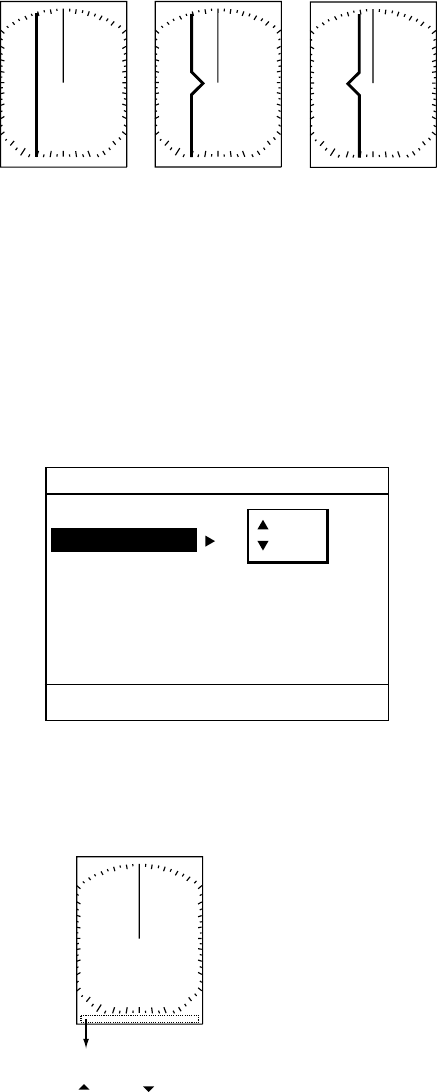
3. INSTALLATION
28
Timing adjustment
Sweep timing differs with respect to the
length of the antenna cable. Adjust sweep
timing to prevent pushing or pulling of the
target as illustrated below and placement of
targets at incorrect ranges.
Correct Target pushed
inward
Target pushed
outward
Improper and correct sweep timings
1. Transmit on a range between 0.125 and
0.5 nm and adjust the sensitivity and A/C
SEA. (See page 4 and 5 for procedure.)
2. Choose TIMING ADJUST from the Radar
Setup menu and press ►.
RADAR SETUP
HEADING ADJUST
TIMING ADJUST
SET ON TIME : 000000h
SET TX TIME : 000000h
[MENU/ESC]: Exit.
: YES
: NO
Radar setup menu (timing adjust)
3. Press ▲ to choose YES, and the display
now looks as below.
SWEEP TIMING ADJUSTMENT BY
’ ’ AND ’ ’ KEYS.
THEN PUSH MODE KEY TO SET.
Message
Timing adjustment display
4. Find a target which should be “straight”
(harbor wall, straight pier) on the radar
display.
5. While looking at the target selected at
step 4, straighten it by pressing ▲ or ▼.
6. Press the [MODE] key.
7. Press the [MENU/ESC] key to return to
the Installation menu to complete the
procedure below, or shut off the power if
no external equipment is connected.
NMEA port setup, GPS WAAS setup
The NMEA port can function as an input port
or input/output port.
If you are using the GP-320B, turn on the
GPS WAAS feature.
1. Show the Installation menu and then
press ▼ to choose NMEA PORT.
2. Press ► to display the NMEA port options
window.
3. Press ▲ or ▼ to choose IN/OUT or IN/IN
as appropriate.
IN/OUT: Input and Output (default setting).
For GP-320B choose this setting.
IN/IN: Input only (Available with
connection of multiple navigators.)
4. If you selected IN/OUT at step 3, press ◄,
▼ to choose NMEA OUTPUT, and then
press ► to display the NMEA OUTPUT
options window.
5. Press ▲ or ▼ to choose OFF or ON.
Choose ON to output input data. Choose
OFF to not output data or if the GP-310B
or GP-320B is connected.
6. Press ◄ to close the window.
7. If the GP-320B is connected, press ▼ to
choose GPS WAAS. Otherwise, go to
step 10.
8. Press ► to open the window.
9. Press ▲ to choose message type.
Note: WAAS is currently in the
developmental stage. While in the
developmental stage choose message
type 02. Change to message type 00
when WAAS becomes fully operational.
10. Turn off the power.
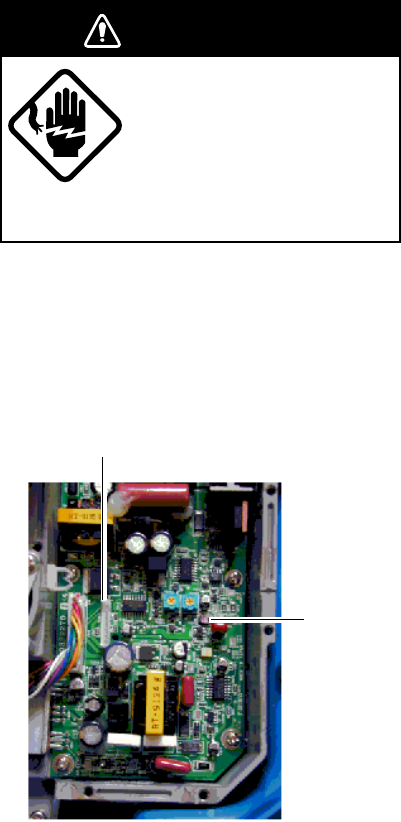
3. INSTALLATION
29
3.5 Magnetron Heater Voltage
Magnetron heater voltage is formed at the
MD Board of the antenna unit and is
preadjusted at the factory. Therefore, no
adjustment is required. However, verify the
voltage as below.
WARNING
ELECTRICAL SHOCK HAZARD
Do not open the equipment.
DO NOT attempt the
procedure below unless
totally familiar with electrical
circuits.
1. Open the antenna cover and open the
shield plate.
2. Turn on the power. DO NOT transmit.
3. Connect a multimeter, set to 10 VDC
range, between #6 (+) and #4 (-) of test
point TP804 on the MD Board.
TP804
VR801
MD board
4. Confirm that the multimeter shows 8.0 V
±0.1 V. If it does not, adjust potentiometer
VR801 on the MD Board.
5. Turn off the power.
6. Fasten the shield plate.
7. Close the antenna cover.
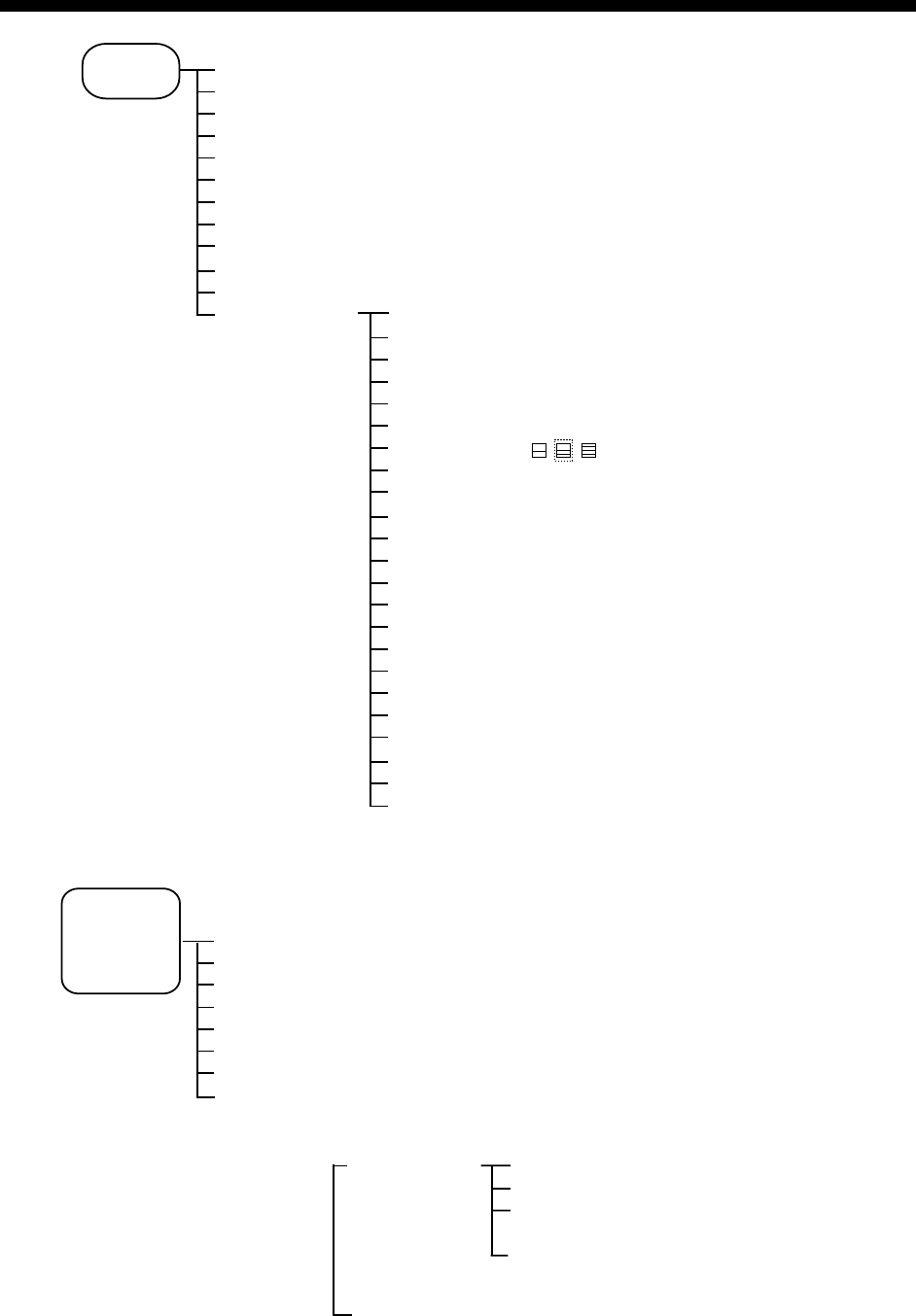
30
MENU TREE
MENU/ESC
key
+
POWER/BRILL
key
SIMULATION (
OFF
, ON, HIGH)
TEST (Tests display unit.)
LCD PATTERN (Displays test pattern.)
MEMORY CLEAR (Restores default menu settings.)
NMEA PORT (
IN/OUT,
IN/IN)
NMEA OUTPUT (
OFF
, ON)
GPS WAAS (
OFF
, WAAS 00-27)
GO TO RADAR SETUP
HEADING ADJUST (Adjusts heading.)
TIMING ADJUST (Adjusts timing.)
SET ON TIME (Displays total hours
radar has been powered.)
SET TX TIME (Displays total hours
of transmission.)
MENU/ESC
key INT REJECTION (OFF,
LOW
, MEDIUM, HIGH)
ECHO STRETCH (
OFF
, LOW, HIGH)
FTC (
OFF
, ON)
NOISE REJECTION (OFF,
LOW
, HIGH)
WATCHMAN TIME (
OFF
, 5, 10, 20 min)
HUE (
DAY
, NIGHT)
PANEL DIMMER (OFF, LOW, MEDIUM,
HIGH
)
HDG LINE OFF (Temporarily turns off heading line.)
ECHO TRAIL (
OFF
, 30 s; 1, 3, 6 min, CONTIN.)
TRAIL BRILLIANCE (
LOW
, HIGH)
TRIPLOG RESET?
SYSTEM MENU LANGUAGE (
ENGLISH
, JAPANESE, Others)
RANGE UNIT (
nm
, km, sm)
DEPTH UNIT (
m
, ft, fa, HR, pb)
SPEED UNIT (
kt
, km/h, mph)
WIND UNIT (
kt
, km/h, mph, m/s)
TEMP UNIT (°C, °
F
)
NAV DATA (OFF, , , )
KEY BEEP (OFF,
ON
)
RINGS (OFF,
ON
)
WAYPOINT MARK (OFF,
ON
)
EBL REFERENCE (TRUE,
RELATIVE
)
BEARING READOUT (TRUE,
MAGNETIC
)
CURSOR POSITION (LAT/LON,
RNG&BRG
)
TRIP SOURCE (
LAT/LON
, SPEED)
WIND SPD/DIR (TRUE,
APPARENT
)
SHIFT MODE (
MANUAL
, AUTO)
AUTO SHIFT SPEED (1-99 (kts),
15
)
TX SECTOR BLANK (
OFF
, ON)
BLANKING START (000-359°,
000
°)
BLANKING AREA (000-135°,
000
°)
LOCAL TIME SETUP (-13:30 - +13:30,
0:00
)
ANTENNA SPEED (24rpm,
AUTO
)
RANGE
nm, sm:
0.125
,
0.25
,
0.5
,
0.75
, 1,
1.5
, 2,
3
, 4,
6
, 8,
12
,
16, 2
4
km:
0.25
,
0.5
,
0.75
, 1,
1.5
, 2,
3
, 4,
6
, 8,
12
,
16, 24, 36
SCANNER TEST (Tests antenna unit.)
Turn on power
Choose GO TO RADAR SETUP
from the INSTALLATION menu,
and then go to page 4 of the
SYSTEM menu.
RADAR SETUP
INSTALLATION
MENU

SP-1
SPECIFICATIONS
1. GENERAL
1.1 Indication System PPI daylight display, raster scan, 4 tones in monochrome
1.2 Range, Pulselength (PL) & Pulse Repetition Rate (PRR)
Range (nm)
0.125, 0.25, 0.5, 0.75 1, 1.5, 2 3, 4, 6, 8, 12, 16, 24, 32
Pulse Length 0.08 µs (short) 0.3 µs (medium) 0.8 µs (long)
Pulse Repetition Rate 3000 Hz nominal 1200 Hz nominal 600 Hz nominal
1.3 Range Resolution 18 m
1.4 Bearing Discrimination 5.2°
1.5 Minimum Range 20 m
1.6 Bearing Accuracy Within 1°
1.7 Range Ring Accuracy 1.0 % of range or 8 m, whichever is the greater
2.ANTENNA UNIT
2.1 Radiator Micro-strip
2.2 Polarization Horizontal
2.3 Antenna Rotation Speed 24/31/41 rpm nominal (auto-select according to range)
2.4 Radiator Length 45 cm
2.5 Horizontal Beamwidth 5.2° typical
2.6 Vertical Beamwidth 25°
2.7 Sidelobe Attenuation Less than -20 dB
3. TRANSCEIVER MODULE
3.1 Frequency 9410 MHz ±30MHz (X-band)
3.2 Modulation P0N
3.3 Peak Output Power 2.2 kW
3.4 Modulator FET Switching Method
3.5 Intermediate Frequency 60 MHz
3.6 Tuning Automatic
3.7 Receiver Front End MIC (Microwave IC)
3.8 Bandwidth 15 MHz (short pulse), 5 MHz (medium/long pulse)
3.9 Duplexer Circulator with diode limiter
3.10 Warm-up Time 1-min. approx.
4. DISPLAY UNIT
4.1 Picture Tube 7” rectangular monochrome LCD
4.2 Display Pixels 240(H) x 320(V) dots,
Effective radar display area: 240x240 dots
4.3 Range, Range Interval, Number of Rings
Range (nm/km) 0.125 0.25 0.5 0.75 1 1.5 2 3 4 6 8 12 16 24 32
Ring Interval 0.0625 0.125 0.125 0.25 0.25 0.5 0.5 1 1 2 2 3 4 6 8
Number of Rings 2 2 4 3 4 3 4 3 4 3 4 4 4 4 4
Range unit: nm/sm/km selectable, 0.125: nm/sm only, 32: km only
SP-2
4.4 Markers Heading Line, Bearing Scale, Range Rings,
Variable Range Marker (VRM), Electronic Bearing Line (EBL),
Tuning Bar, Cursor, Parallel Cursor, Alarm Zone,
Waypoint Mark*, North Mark*
4.5 Alphanumeric Indications Range, Range Ring Interval, Display Mode (HU),
Interference Rejection (IR), Variable Range Marker (VRM),
Electronic Bearing Line (EBL), Stand-by (ST-BY),
Guard Alarm (G (IN), G (OUT), UP RANGE), Echo Stretch (ES),
Range and Bearing to Cursor, Bearing or L/L Position,
Echo Tailing (TRAIL), Trailing Time, Trailing Elapsed Time,
Watchman (WATCHMAN), Zoomed Display (ZOOM),
Navigation Data*, Heading* *: external data required
4.6 Input Sentences IEC61162, NMEA0183 (Ver1.5/2.0) GGA, RMC, RMA, RMB,
GLL, VTG, VBW, VHW, HDT, HDG, HDM, BWR, BWC, GLC,
GTD, DPT, DBK, DBS, DBT, MTW, ZDA, MWV, XTE
4.7 Output Sentences IEC 61162, NMEA 0183 (Ver3.0)
TLL (by key operation)
5. ENVIRONMENTAL CONDITIONS
5.1 Ambient Temperature Antenna Unit: -25°C to +70°C, Display Unit: -15°C to +55°C
5.2 Relative Humidity 95% or less at +40°C
5.3 Waterproofing Antenna Unit: IPX6
Display Unit: IPX5 (IPX0 when an external buzzer installed)
5.4 Bearing Vibration IEC 60945
6. POWER SUPPLY
12-24 VDC: 3.2-1.4 A
7. COATING COLOR
7.1 Display Unit N3.0
7.2 Scanner Unit Cover: N9.5, Bottom: 2.5PB 3.5/10
8. COMPASS SAFE DISTANCE
8.1 Display Unit Standard: 0.60 m Steering: 0.40 m
Scanner Unit Standard: 1.25 m Steering: 0.85 m
